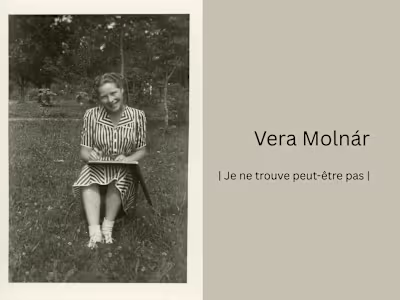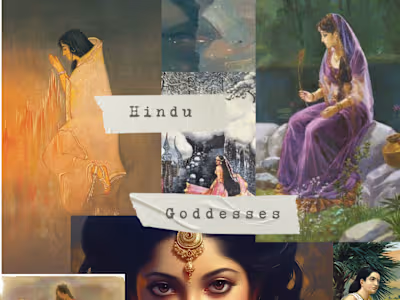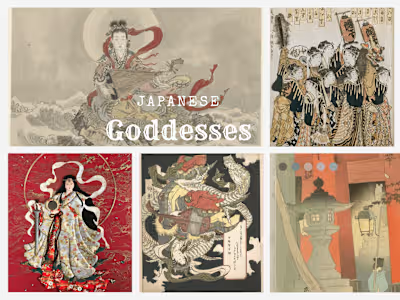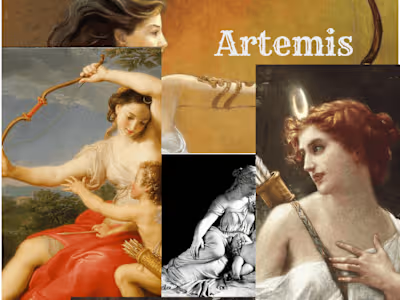Goddesses of the North: The Women of Norse Mythology
Freya: Goddess of Love, Beauty, and Magic
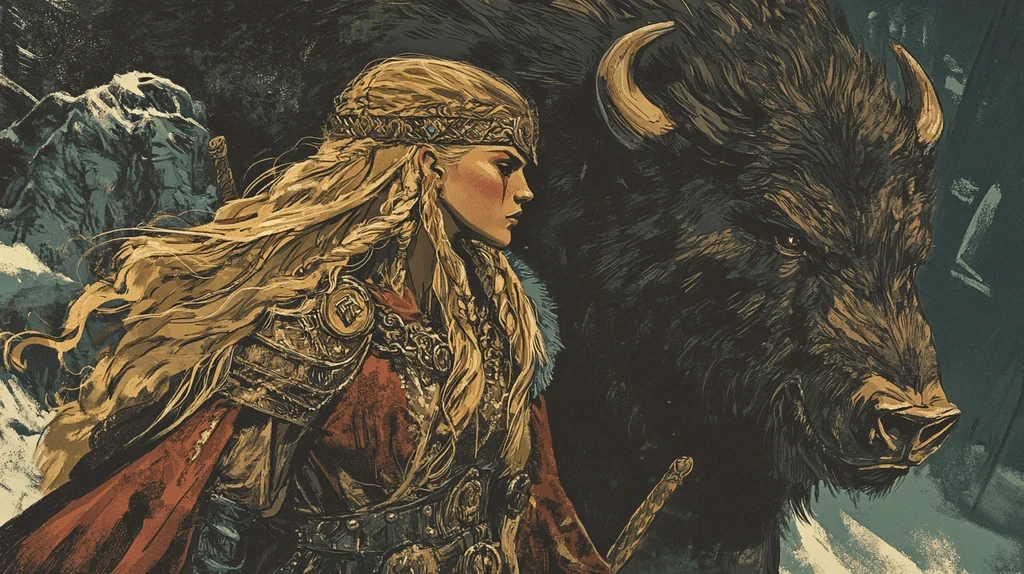
Source: Paganheim
The Norse mythological tradition is replete with rich and complex figures, and among them, one character stands out for her compelling blend of otherworldly allure and unyielding strength. Known as Freyja or Freya, this deity occupies a highly respected position in the Norse pantheon, revered for her multifarious attributes and formidable powers. Hailing from the realm of the Aesir, she plays a critical role as the goddess of love, beauty, and magic, with her influence extending across a range of titles, defining characteristics, and potent symbols. A closer examination of her mythological narrative reveals a figure whose impact transcends the confines of ancient Norse culture, leaving an indelible mark on both the divine and mortal realms.
Overview of Freya
Freya, also known as Freyja, holds a prominent position within Norse mythology as a member of the Aesir tribe, a group of deities residing in Asgard, the celestial realm of gods. Freyja, derived from the proto-germanic feminine noun frawjōn, translates to ‘lady,’ ‘woman,’ or ‘mistress,’ thus underscoring her significance among the Norse deities (Lockett).
Freya embodies a multifaceted character, representing the essence of love, fertility, beauty, and magic, making her a captivating and enigmatic figure deeply intertwined with the hearts and beliefs of the Norse populace. Her radiance and potency have made her a powerful symbol in Norse mythology, revered for her many attributes and influence over the natural world.

Source: The Troth
Titles
Queen of the Valkyries
Lady of the Vanir
Goddess of Love
The Seeress
Abilities
Freyja is known for her exceptional range of abilities and remarkable influence. Her mastery of Seidr, a complex form of Norse magic associated with divination and fate manipulation (Lockett), has earned her recognition as the foremost practitioner of this skill. With her mastery of Seidr, Freyja can perceive the intricate threads of destiny and shape them to her advantage (Groeneveld).
In addition to her mastery of Seidr, Freyja possesses a falcon-feathered cloak that endows her with the power to transcend the mortal realm and travel effortlessly between different domains. This garment enables her to cover vast distances in the blink of an eye (Apel). This skill signifies her dominion over various dimensions and solidifies her status as a goddess of unparalleled power. Freyja’s connection to the cycles of life and creation is further deepened by her divine tears, which possess an extraordinary capability. When these tears fall, they transform into precious amber, a tangible manifestation of her profound link to the very essence of life (Dowdeswell). This symbolic transformation underscores her role in the circle of existence, where birth, growth, and eventual change are integral.
Characteristics
Freyja emerges as a luminous embodiment of beauty, radiance, and sensuality, captivating the hearts and imaginations of mortals and gods alike (“Freyja – New World Encyclopedia”). Her portrayal is of ethereal elegance, often depicted with golden tresses cascading like sunbeams, as a tangible representation of her divine luminance (Dowdeswell). This radiant mane symbolizes her status as a goddess who holds sway over matters of allure and fertility, further affirming her role as a beacon of vitality within the pantheon (Groeneveld).
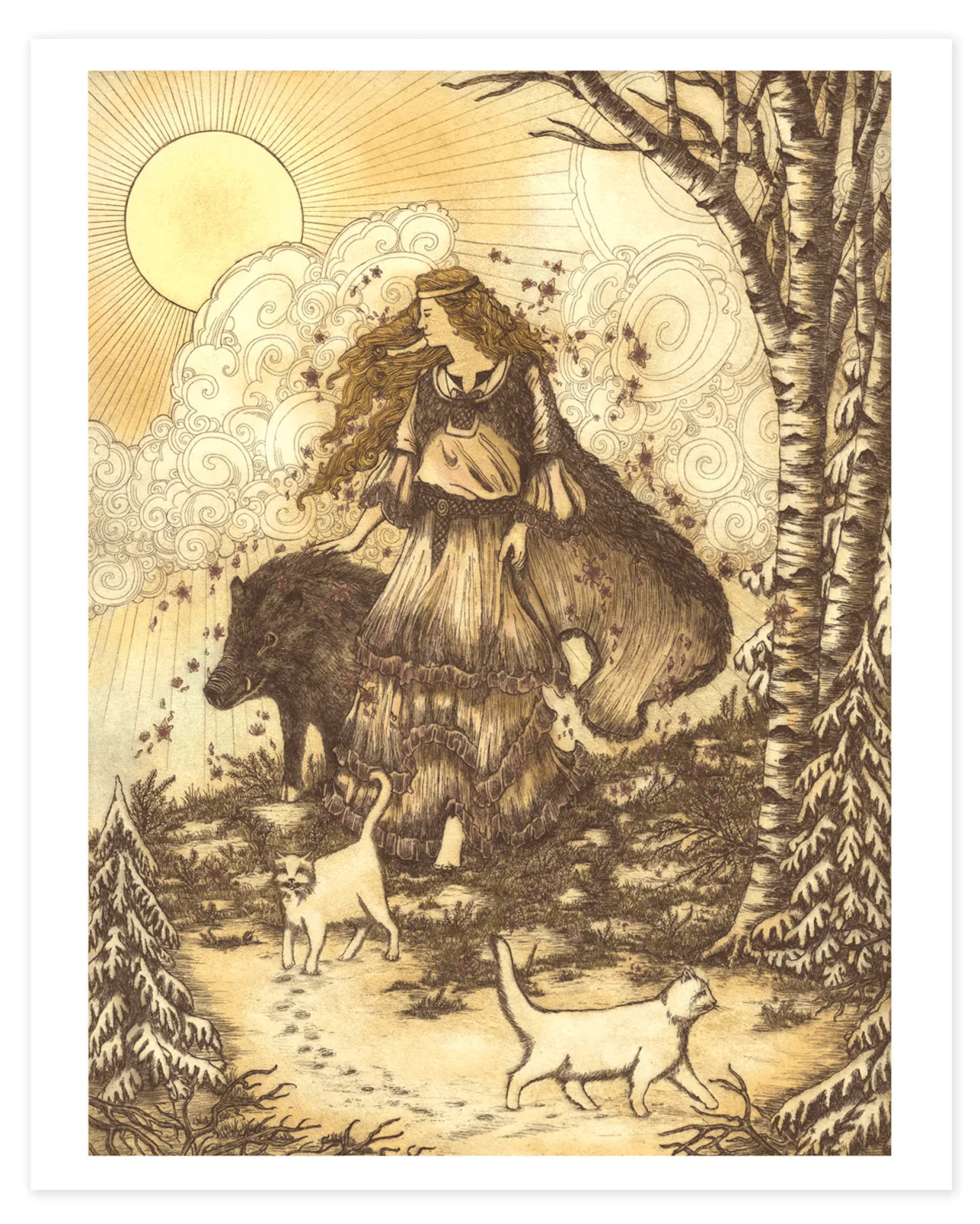
Source: Etsy
Traits
At the heart of her character are fierce independence and unwavering determination, which empower her to navigate the intricate web of both divine and mortal realms (Lockett). Freyja’s spirit burns passionately in matters of love and as a formidable warrior goddess (Dowdeswell). Her battlefield prowess and courage in the face of conflict testify to her dual nature—a harmonious blend of ethereal beauty and indomitable strength (Groeneveld).
Her compassionate heart is central to her character, a trait that extends beyond her divine form to touch the lives of her devotees and loved ones (Wikipedia Contributors). Her willingness to offer aid and protection underscores her role as a goddess of love and familial bonds, forging connections that transcend the boundaries between mortals and deities (Apel). This capacity for empathy enhances her allure, endearing her as a deity of power and a beacon of benevolence. Freyja’s traits form a mosaic of contradictions and harmonies, weaving a narrative that encompasses her internal conflicts and her capacity for empathy and strength. Her character reflects the intricate dance between vulnerability and grit, mirroring the complexities of the human experience while embodying the divine spirit that sets her apart in Norse mythology.
Symbols
The essence and dominion of Freyja encapsulate various evocative symbols that speak to her multifaceted role (Groeneveld). Among these symbols, the Brísingamen stands out as the most iconic (Lockett). Skilled dwarves crafted this enchanting necklace as a testament to her exalted position and a potent representation of her association with love and beauty. Through its exquisite embodiment of her allure and fertility, the Brísingamen captures the very essence of her divine nature (Apel).
Another symbol that resonates with Freyja’s essence is her chariot, drawn by two majestic felines (Dowdeswell). These creatures mirror her independent and enigmatic nature and add an air of mystery to her character. Additionally, her affinity for cats enhances her connection to the animal realm, further establishing her dominion over the natural world. These symbols vividly depict Freyja’s essence, weaving together the beauty and power that define her enduring presence within Norse mythology.
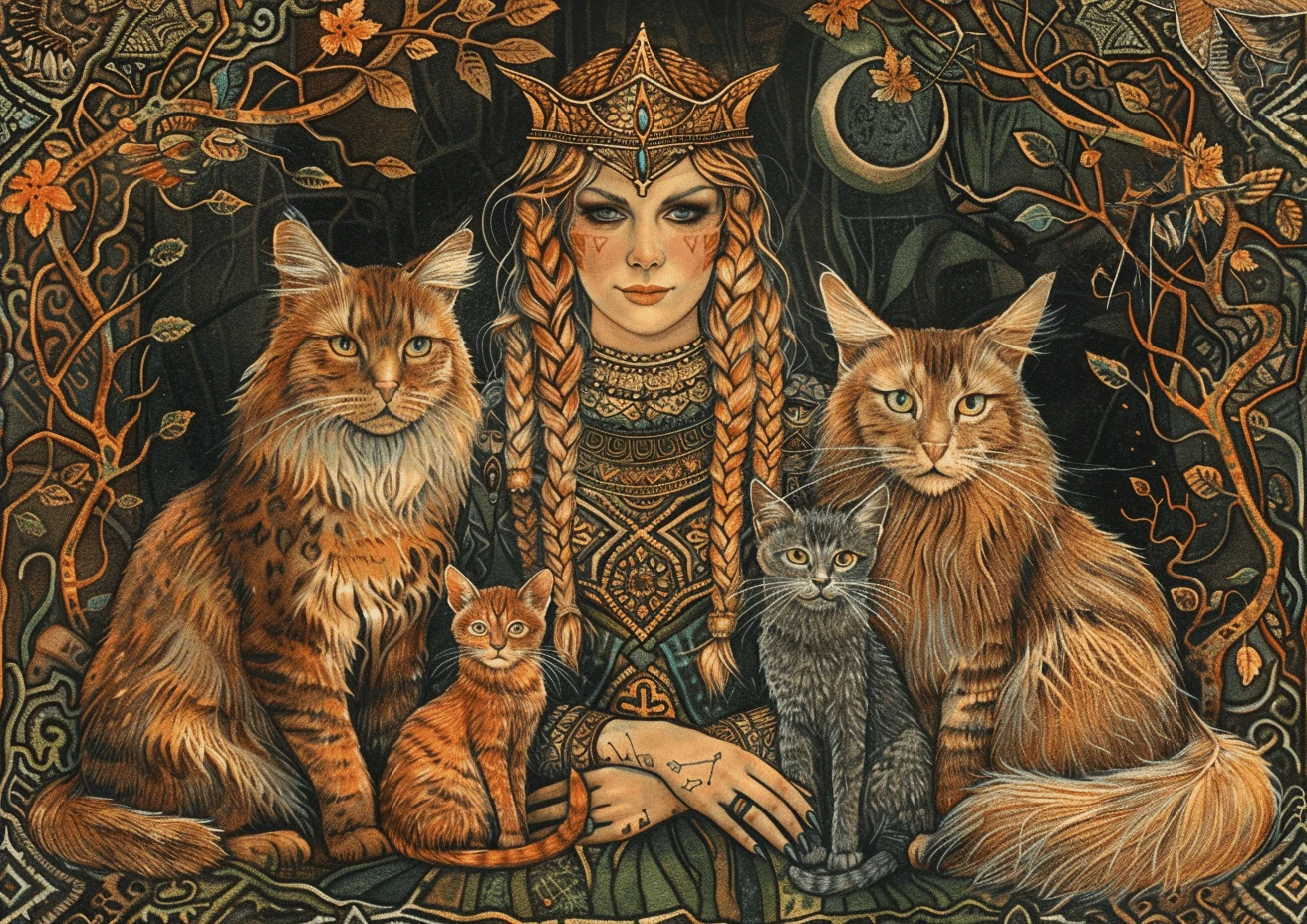
Source: Mowbi Wholesale
Festivals and Rituals
The influence of Freyja extends beyond her divine attributes and is expressed through various rituals and festivities. One such celebration is the “Freyfaxi” festival, which takes place during the harvest season and pays tribute to Freyja’s significant role as a fertility goddess. During this festival, devotees express gratitude and make offerings to secure bountiful crops and prosperity (Lockett), honoring Freyja’s power as a source of abundance and her connection to the cycles of life and nature. The “Freyfaxi” festival is a vibrant commemoration that underscores the profound significance of Freyja within Norse culture.
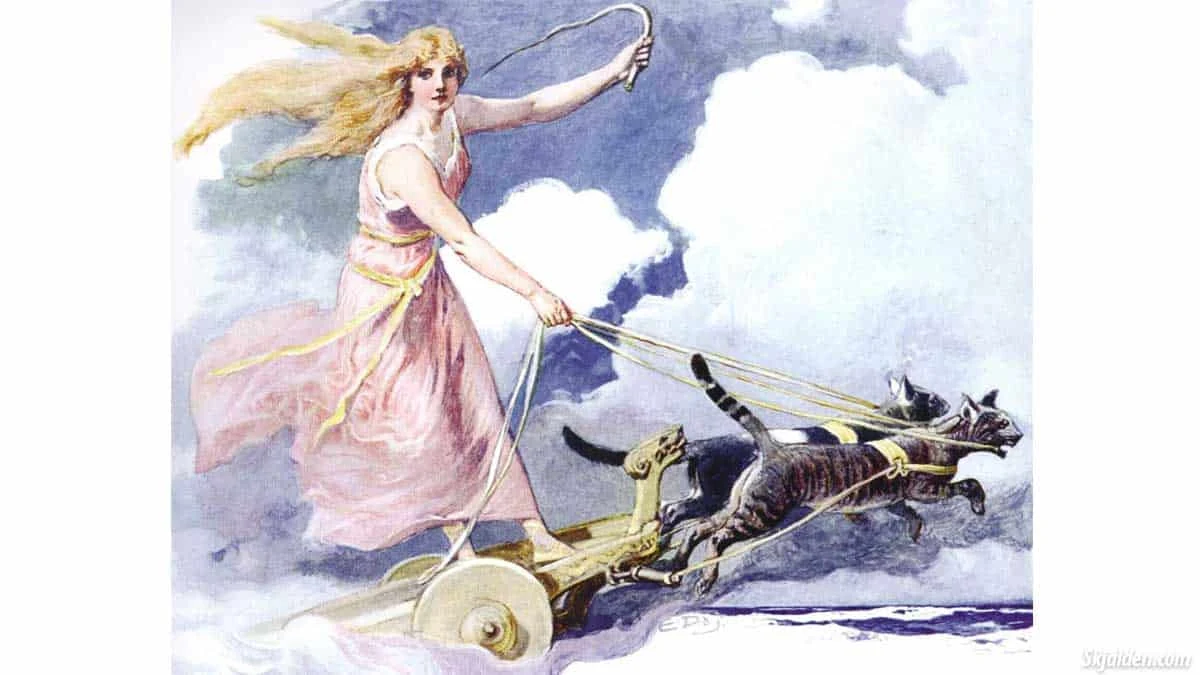
Source: Nordic Culture
Legends associated with Freya
Among the divine beings of Norse mythology, Freya stands out as a figure of unparalleled intrigue, embodying the delicate balance between power and love. The legends associated with Freya are as diverse as they are enchanting, weaving together intricate narratives that bring to light the multifaceted aspects of this deity’s character. From her associations with fertility and sexuality to her role as a mighty warrior and leader, Freya’s tales offer a glimpse into a world of myth and imagination that continues to captivate and inspire us today.
Origin story
At the core of Freya’s mythology lies an origin narrative that serves as the foundation of her divine presence. Freya is recognized as the daughter of Njord, the sea god, and the twin sister of Freyr, the deity associated with fertility and prosperity. This lineage shows her intrinsic connection with the natural world, with her father’s reign over the vast oceans and her brother’s role in the cycle of life.
However, the origin tale of Freya comprises intriguing variations, each of which amplifies her significance within distinct contexts. In the pages of the “Gylfaginning” segment of the Prose Edda, a valuable compilation of Norse myths, Freya emerges as a revered member of the Vanir, the tribe of deities acknowledged for their association with fertility and prosperity. This tale unfolds with Freya being dispatched to dwell among the Aesir, the primary pantheon of Norse gods, as a symbol of peace after the tumultuous Aesir-Vanir war (Wikipedia Contributors). This transition highlights her pivotal role as a mediator, bridging the divide between warring factions and signifying her profound influence in forging harmony among the divine entities.
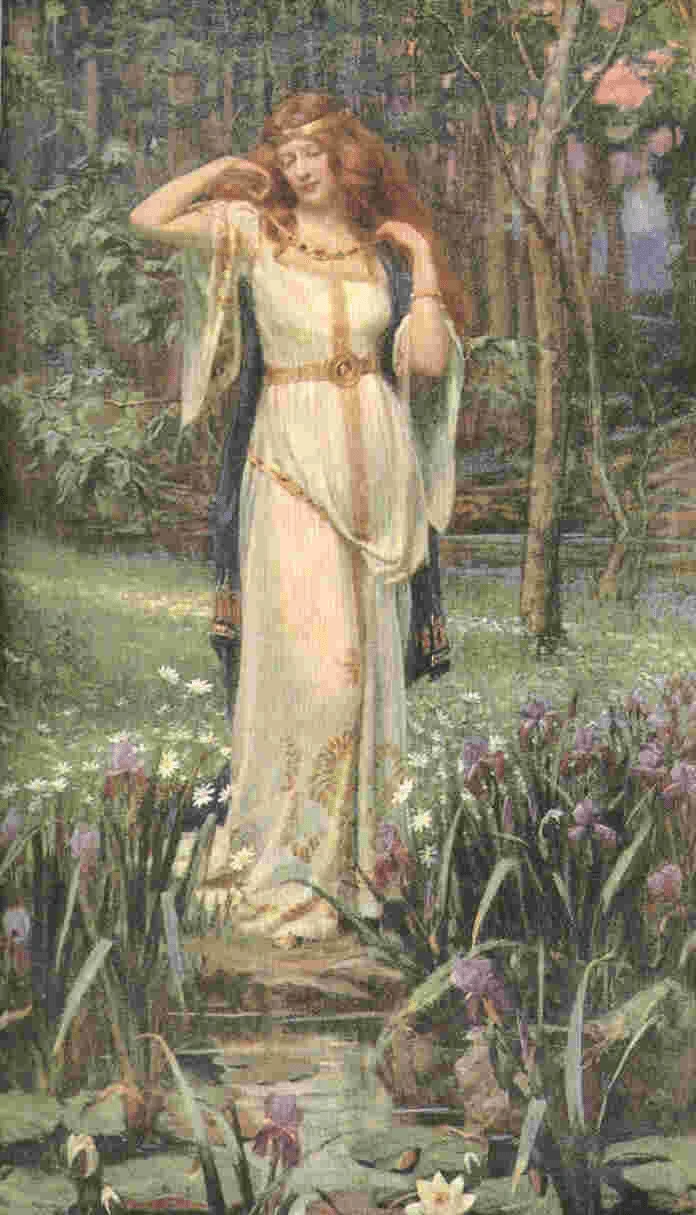
Source: Norse Mythology for Smart People
The Acquisition of the Brísingamen
According to the captivating legends within Freya’s mythology, the acquisition of the Brísingamen, a legendary necklace of extraordinary beauty and significance, has remained a tale of great intrigue. It is said that Freya�’s desire for the Brísingamen led her to the domain of skilled dwarves, who held the power to forge such a masterpiece. These dwarves, recognizing the allure and importance of the necklace, offered it to Freya in exchange for a price that resonated with her captivating nature – a night spent with each of them.
Despite the societal norms and expectations that would have deterred most, Freya remained undeterred and guided by her agency. She agreed to their terms, revealing her unapologetic embrace of her desires and independence. This narrative serves as a testament to the enduring power of Freya’s mythos and the value she placed on her autonomy and the pursuit of her desires, even in the face of societal expectations and norms (Apel).
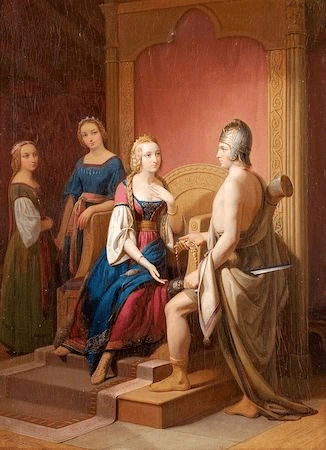
Source: Study
Freya and Odin: A Mythical Tale of Wisdom and Magic
An enthralling legend within Norse mythology depicts the intriguing connection between Freya, a revered deity associated with beauty and love, and Odin, the chief god of the Norse pantheon. In this mesmerizing narrative, Freya assumes the role of a teacher, imparting her profound wisdom to Odin himself. The tale highlights Freya’s exceptional mastery of mystical arts and her deep insight into the threads of destiny as she introduces Odin to the intricate art of Seidr, a form of Norse magic that involves divination and manipulating fate (Groeneveld).
This knowledge exchange underscores Freya’s pivotal role as a powerful seeress whose gaze reaches beyond the ordinary realms, perceiving the intricate tapestry of existence. It further elevates her position as a deity who commands not only beauty and love but also the profound mysteries of the cosmos. Her ability to bestow wisdom upon even the highest of gods reinforces her status as a figure of extraordinary influence and power within the Norse pantheon. As the bearer of divine secrets and the keeper of arcane arts, Freya’s connection with Odin solidifies her legacy as a goddess of unparalleled insight and mystique.

Source: Reddit
Influences of other religions/cultures on Freya
A fascinating perspective emerges when considering the potential connection between Freya and Frigg, the Germanic goddess and Odin’s wife (Dowdeswell). This suggestion highlights the fluid nature of mythological attributes and the intricate intermingling of beliefs as cultures evolved and interacted.
The resemblance between Freya and Frigg raises questions about the shared narratives and attributes these goddesses may embody. While Freya’s dominion lies in love, beauty, and fertility, Frigg is often associated with household, family, and domesticity matters. The notion that these two distinct deities might share commonalities underscores how myths and cultural nuances can transcend boundaries. The convergence of Freya and Frigg echoes the intertwining threads of different belief systems, illustrating how mythologies evolve and adapt in response to diverse cultural contexts. This dynamic relationship between deities, shaped by the ever-shifting landscapes of human imagination and interaction, serves as a poignant reminder of the fluidity and complexity of religious beliefs and their timeless impact on the human experience.
Modern appearances
The timeless allure of Freya has endured into the present era, gracefully transcending the limitations of ancient texts and resonating deeply within various aspects of contemporary culture, literature, and spiritual practices. The prominence of Freya within popular consciousness experienced a revival during the emergence of Germanic nationalism in the nineteenth century. Notably, Freya was referenced in the Danish national anthem penned by Adam Oehlenschläger, titled “Der er et indigo land” (“There is a Lovely Land”), wherein “old Denmark” was described as “Freya’s hall.” (Apel). In recent times, Freya also appeared in the popular video game God of War as The Witch in the Woods.
Final thoughts
The Norse goddess Freya, known for her embodiment of love and power, is a figure of great complexity and allure in mythology. Her origin story, rich with captivating nuances, unfolds alongside her dynamic interactions with fellow deities, painting a vivid portrait of her influential presence. Across diverse cultures and epochs, the enduring impact of Freya remains a testament to the eternal interplay between beauty, strength, and love. These tales, resonant with profound insights, serve as a continuous source of inspiration, reminding us of the enduring potency of mythology in its capacity to reflect and shape the essence of the human experience.
References
Apel, Thomas . “Freya.” Mythopedia, 18 Nov. 2021, mythopedia.com/topics/freya.
Dowdeswell, Molly. “The Story, Symbols and Powers of Freya, the Norse Goddess of Love.” Www.ancient-Origins.net, www.ancient-origins.net/myths-legends-europe/freya-norse-goddess-0017280.
“Freyja – New World Encyclopedia.” Www.newworldencyclopedia.org, www.newworldencyclopedia.org/entry/Freyja.
Groeneveld, Emma. “Freyja.” World History Encyclopedia, 19 Feb. 2018, www.worldhistory.org/Freyja/.
Lockett, Rachel. “Freyja: The Norse Goddess of Love, Sex, War, and Magic | History Cooperative.” History Cooperative , 4 Jan. 2023, historycooperative.org/freyja-the-norse-goddess-of-love/#:~:text=The%20name%20Freyja%20in%20Old. Accessed 11 Aug. 2023.
Wikipedia Contributors. “Freyja.” Wikipedia, Wikimedia Foundation, 6 Nov. 2019, en.wikipedia.org/wiki/Freyja.
Frigg: The Norse Goddess Of Motherhood and Fertility
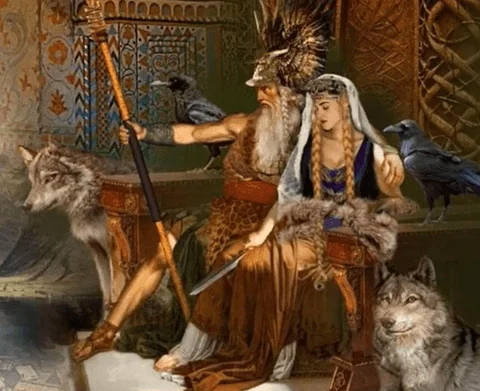
Source: Viking Heritage Store
In the fascinating realm of Norse mythology, Frigg, the Norse Goddess of Motherhood and Fertility, holds a renowned position as Queen of the Aesir and Guardian of the Hearth. As the Queen of the Aesir, she occupies a regal position in Asgard, the realm of the gods, while her role as the Guardian of the Hearth highlights her nurturing and protective qualities, emphasizing her crucial significance to the daily lives of mortals. From her enigmatic origins to her enduring influence on modern culture, Frigg's presence permeates the very fabric of Norse mythology, offering profound insights into the intricacies of the ancient worldview.
Overview of Frigg
As the beloved wife of Odin, the goddess's name Frigg derives from the Old Norse term "Frigg" or "Frigga," which is itself derived from the Proto-Germanic *Frijaz, meaning "beloved, dear" (Apel). However, the goddess's influence extends far beyond mere domesticity. As the Aesir Queen and Guardian of the Hearth, her importance encompasses cosmic domains. Frigg's position as a divine mother and goddess of fertility, as well as her association with love, marriage, and wisdom, further underscores the depth and richness of her character.
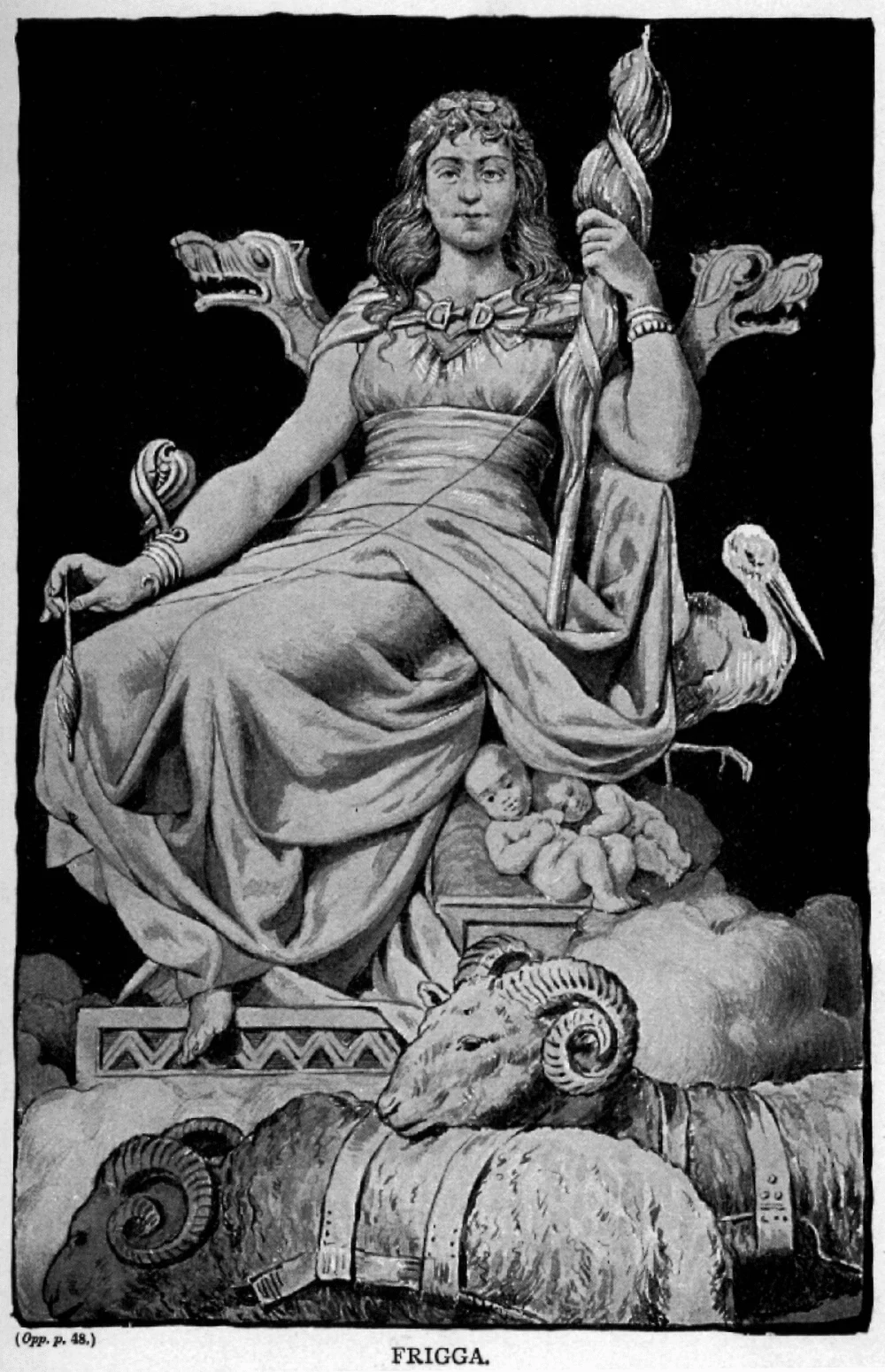
Source: The Troth
Titles
Queen of Heaven
Sky Goddess
Mother of All
Abilities
The awe-inspiring abilities of the Norse goddess of wisdom are as diverse as her many titles. Among her most remarkable attributes is her extraordinary gift of prophecy and foreknowledge. This skill shapes events within the Norse pantheon and beyond (“Frigg”). Renowned for her unparalleled capacity to foresee future occurrences, Frigg is an invaluable advisor to the gods, guiding their decisions through her far-reaching insights (“Frigg Overview, Mythology & Facts | Who Is the Norse God Frigg?”). As a matter of fact, Frigg's unrivaled wisdom surpasses many deities within the Norse pantheon; this lends her counsel a particular gravitas, making her a trusted source of guidance.
Furthermore, Frigg wields the profound ability to influence fate itself, a power that underscores her connection with the intricate tapestry of destiny. As a masterful weaver, she deftly intertwines the destinies of mortals and immortals, using her complex threads of fate to shape outcomes, according to the History Cooperative. This unique ability to manipulate the fabric of existence enhances her role as a pivotal figure within Norse mythology, accentuating her unparalleled influence on the gods' actions and the destinies of all beings.
Frigg's diverse abilities and unmatched wisdom make her a remarkable figure in the annals of mythology and an enduring source of inspiration for future generations.
Characteristics
Frigg is undoubtedly a regal and majestic figure, emanating an aura of authority and grace that is second to none. Her maternal warmth and profound sense of protection and care are unmistakable and are often depicted in her mature physical appearance, embodying the essence of nurturing and guardianship. Throughout Norse mythology, Frigg's unyielding determination, wisdom, and inner strength have all contributed to her formidable presence within the pantheon. Her lavish gowns and robes, her hair typically a resplendent blonde hue, always accentuates her power and influence.
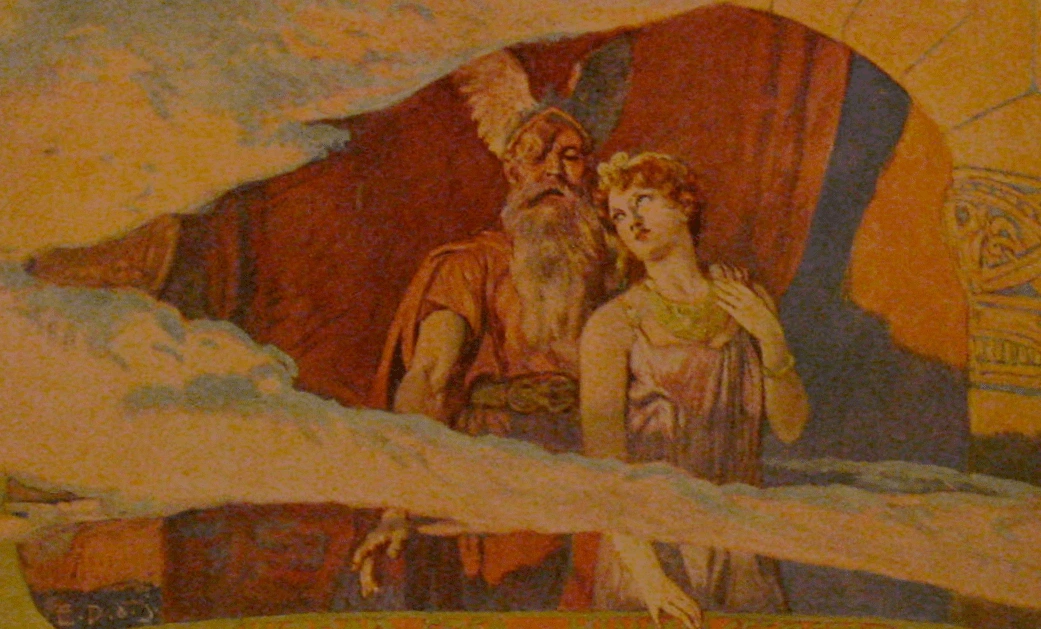
Source: World History Encyclopedia
Traits
Frigg's personality traits encompass diverse attributes, illuminating her intricate character within Norse mythology. Her compassionate and nurturing demeanor is particularly evident in her role as the mother of Baldr, the venerated god of light (Apel). This maternal instinct underscores her capacity for love and care, emphasizing her role as a foundational figure in the divine family dynamic.
Frigg's devotion to her family is a testament to her unwavering loyalty and determination. Her readiness to go to great lengths to safeguard her loved ones from harm reinforces her status as a steadfast protector. Despite her regal stature as the queen of the Aesir, Frigg remains approachable and relatable. Her relatability is further highlighted by her ability to forge connections with gods and mortals through her deep understanding and empathy (Dhar). This empathetic disposition bridges the gap between the divine and the mortal, endearing her to those she guides and influences within the Norse pantheon.
Symbols
To fully understand Frigg's significance and influence it is necessary to explore the intricate symbolism surrounding her character. The spindle and distaff, which are tools emblematic of weaving, profoundly represent her role as the weaver of fate (“Frigg”). Through the intricate crafting of the destinies of all beings, Frigg shapes the paths of their lives, highlighting the interwoven nature of existence itself.
The mistletoe plant is integral to Frigg's symbolism, embodying themes of tragedy and renewal within her stories. While it becomes an instrument of Baldr's downfall, it symbolizes his eventual resurrection, evoking themes of sacrifice and rebirth (“Frigg Overview, Mythology & Facts | Who Is the Norse God Frigg?”). These symbols collectively capture the profound essence of Frigg's intricate character, encapsulating her deep connection to the cycles of fate, life, and death that shape the Norse cosmos.
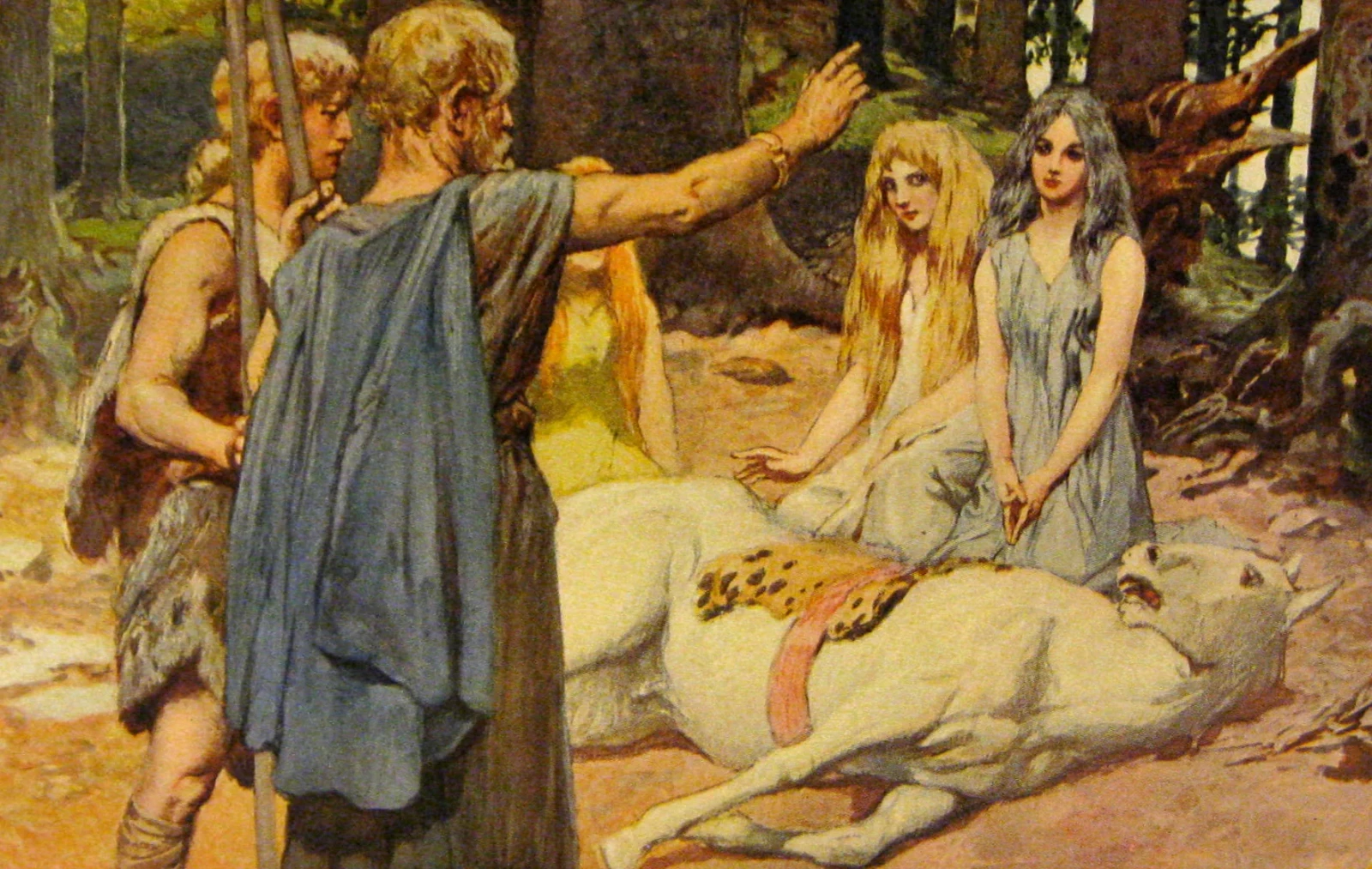
Source: Myth and Folklore Wiki
Festivals and Rituals
The immortal Frigg is commemorated through various festivals and rituals that pay homage to her dual roles as a powerful deity and a nurturing guardian. Among these observances, the Dísablót stands out as a poignant event dedicated to venerating female Gods like Frigg. During this solemn occasion, offerings are made to pray for these powerful goddesses' safeguarding influence and blessings upon the community (“Frigg”). This ritual underscores Frigg's maternal and protective attributes, emphasizing her role as a guardian and guide.
Another notable celebration that pays tribute to Frigg is the Winter Nights festival, a momentous occasion signifying the transition from summer's warmth to winter's cold embrace (“Frigg”). As part of this festival, feasting and offerings are extended to Frigg and other deities, invoking their favor for the impending season. By participating in such rituals, individuals seek to forge a deeper connection with Frigg, gathering her nurturing presence and wisdom to guide them through the cyclical changes of life. These traditions are deeply ingrained in Norse culture and honor Frigg's indelible presence as a divine and protective force.

Source: Wikipedia
Legends associated with Frigg
Frigg's enduring impact on contemporary culture is evident from her mysterious origins to the tragic demise of her son. The richness of her character and her role in the pantheon of Norse gods make her an iconic figure that continues to fascinate scholars and enthusiasts alike.
Origin story
The intricacies of Norse mythology reveal a fascinating tale of divine and earthly connections through the parentage of the goddess Frigg. According to myth, Frigg's lineage can be traced back to the giants Fjörgyn and Fornjót, the feminine and masculine of one entity. Fjörgyn, the embodiment of the earth's essence, is often attributed as Frigg's mother, imbuing her with nurturing and grounding qualities derived from the land (“Frigg”). In contrast, the masculine form Fornjót, associated with the sea, is said to occasionally assume the role of Frigg's father, endowing her with elements of mystery and fluidity from the waters.
As Frigg ascends to divinity, she carries a unique amalgamation of traits inherited from both the feminine and masculine - the power of the earth and the enigma of the sea. Her birth symbolizes a delicate balance between the worlds of gods and giants, casting a prophetic light on her crucial role as a bridge between these distinct realms (“Frigg”). This equilibrium highlights her significance as a mediator, protector, and figure who traverses boundaries, embracing the diversity of her heritage while uniting disparate dimensions within the cosmos.
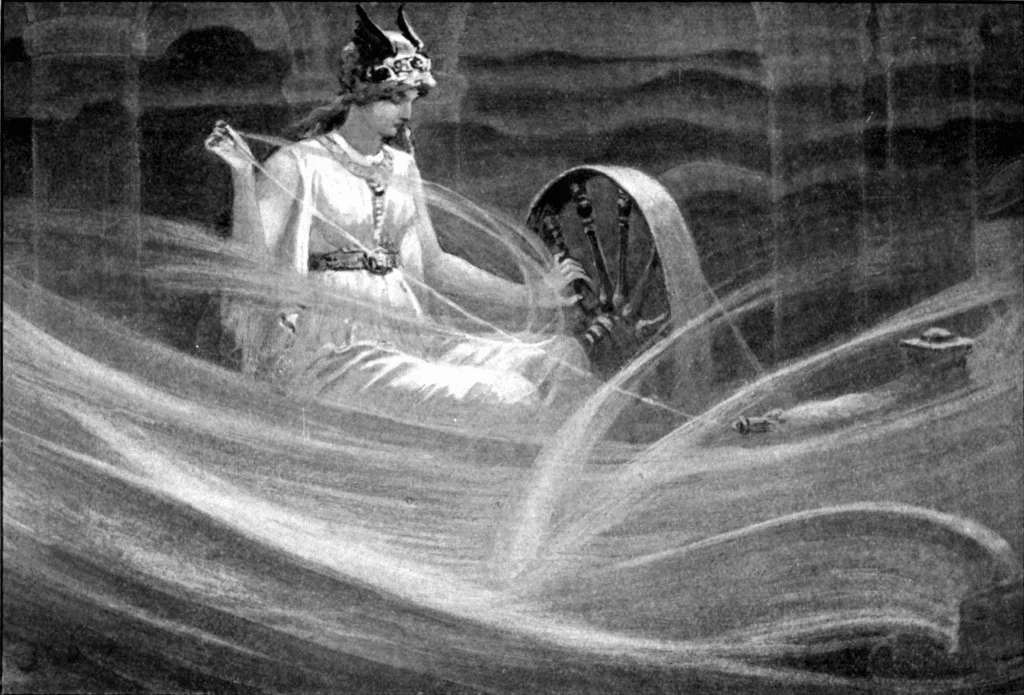
Source: Norse Mythology for Smart People
Baldr's Tragic Demise and Frigg's Overwhelming Grief
The legend of Frigg's character is steeped in many tales, among which is the tragic story of her son Baldr. Baldr, renowned for his beauty, purity, and invincibility owing to his mother's efforts, was a beloved figure among the Aesir gods and mortals. As Baldr's mother, Frigg was vigilant in ensuring her son's safety and secured oaths from all beings and elements to prevent any harm (“Frigg”). However, Loki, the cunning trickster god, discovered a loophole in Frigg's protective measures. He fashioned an arrow from mistletoe and deceived Baldr's blind brother, Hodr, into using it during a friendly game, ultimately causing Baldr's death. The tragedy of Baldr's death cast a long shadow over both gods and mortals, shattering the harmony and joy that had once prevailed in the divine realms.
Frigg's reaction to Baldr's death was one of inconsolable grief. Her motherly love and tireless efforts to safeguard her son were in vain, and the pain of his loss was deeply felt. The depth of Frigg's emotional turmoil resonated throughout the cosmos, underscoring the complexity of her character. This poignant tale, a reflection of the interplay between love and destiny, finds its resonance in both the "Poetic Edda" and the "Prose Edda" (“Frigg Overview, Mythology & Facts | Who Is the Norse God Frigg?”).
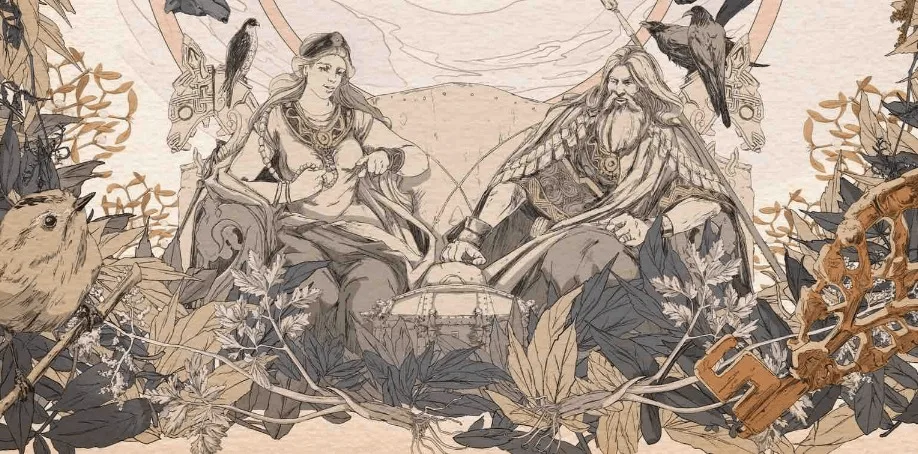
Source: Soldiser
The Lost Necklace: Uncovering Frigg's Wisdom
A notable tale that showcases Frigg's brilliant strategic insight and sagacity revolves around the story of the missing Brísingamen necklace. As per the legend, Frigg confided in Fulla about her strong desire to possess the exquisite and valuable necklace, Brísingamen, an exceptional masterpiece crafted by four dwarf brothers known as the Brísingar. These dwarfs had offered the necklace to Freyja, the goddess of love and fertility, in exchange for spending a night with her. However, Freyja refuses to part with the necklace to Frigg, leading to a conflict.
Observing Freyja's attachment to the necklace, Frigg shared her secret longing with Fulla. Recognizing Frigg's desire and the significance of the ornament and driven by her loyalty and compassion, Fulla employs shrewd diplomacy to assist Frigg in retrieving the necklace (Apel). She approached Freyja and convinced her to lend the chain to Frigg briefly, utilizing her persuasive skills. With Fulla's diplomatic assistance, Frigg wore the necklace temporarily. However, the necklace was eventually returned to Freyja, and the story concluded with no significant consequences.
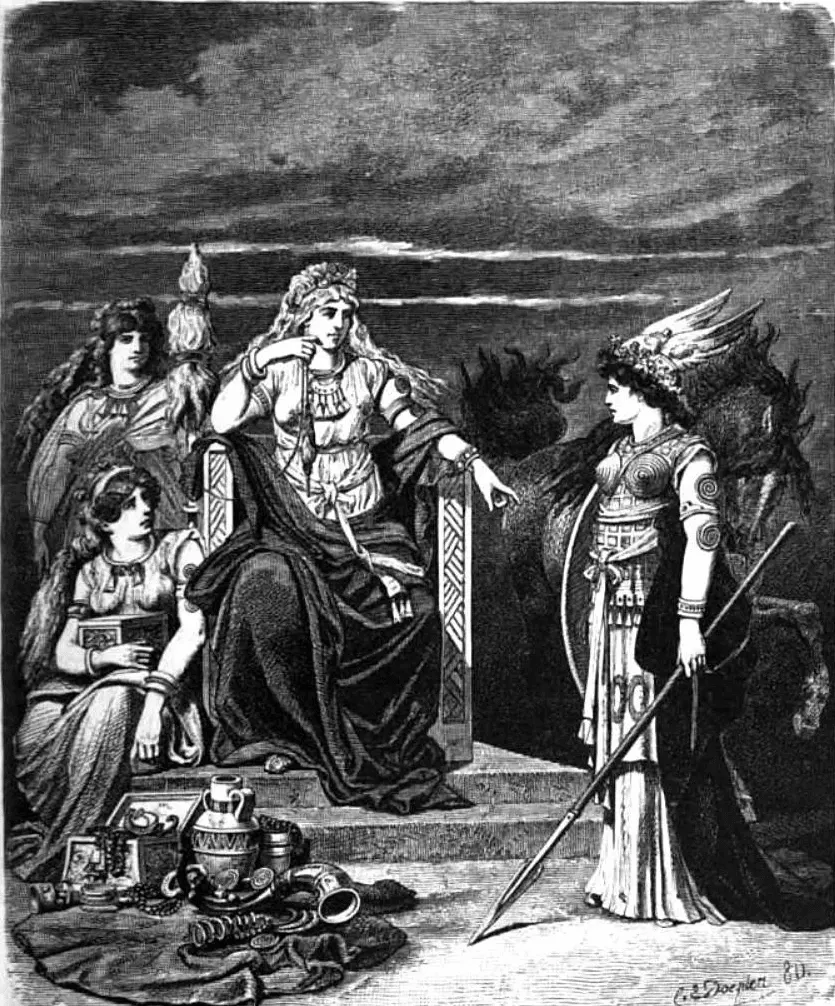
Source: Myth and Folklore Wiki
Influences of other religions/cultures on Frigg
Norse mythology underwent a series of transformations as it interacted with evolving cultures and belief systems, much like many other ancient belief systems. As Christianity began to gain prominence, the portrayal of deities such as Frigg underwent a process of reinterpretation to align with the new religious paradigm. Frigg, renowned for her roles as a protective mother and a wise seeress, found aspects of her character assimilated into Christian concepts (Apel).
The qualities that made Frigg a revered figure were recontextualized within the Christian framework, allowing her to bridge the gap between pagan and Christian beliefs. Her maternal instincts and foresight resonated with Christian values of compassion and divine insight, thus aiding in the gradual acceptance of these mythological figures within the changing cultural landscape (“Frigg”). This syncretic process showcased the fluidity of mythic narratives, demonstrating their capacity to adapt while retaining their core attributes.
Frigg's transformation is symbolic of the complex interplay between religious systems and the flexibility of mythology to adapt to the evolving beliefs of different eras. This evolution is a testimony to ancient narratives' enduring significance and adaptability, even amidst cultural shifts.
Modern appearances
The resurgence of global interest in ancient belief systems has led to a renewed appreciation for deities such as Frigg, whose significance extends beyond the pages of historical texts to play a vital and enduring role in modern spiritual practices. The revival of neo-paganism and Norse-inspired traditions has breathed new life into the devotion and reverence for figures like Frigg, reigniting a powerful connection with the divine that transcends time (Dhar) and space, and inspires contemporary rituals, ceremonies, and celebrations.
Indeed, contemporary expressions of spirituality often draw upon historical sources to honor the Norse pantheon, with Frigg occupying a central place in these modern-day observances. These practices serve as a tangible bridge between the present day and the ancient past, allowing individuals to forge a deeper connection with their ancestral heritage and tap into their forebears' rich cultural and spiritual traditions. Frigg's portrayal as a nurturing and protective goddess has found resonance among those who seek a link to nature-based spirituality and a connection to ancient wisdom (“Frigg Overview, Mythology & Facts | Who Is the Norse God Frigg?”). Her qualities as a guardian and a provider of solace hold a particular allure in a modern world that often yearns for a deeper relationship with the natural world and the divine forces that shape it.
Final thoughts
The lore surrounding the enigmatic Norse goddess Frigg is nothing short of fascinating. Her stories intertwine themes of fate, motherhood, wisdom, and influence, shedding light on the intricacies of the Norse worldview. Frigg's legacy remains a subject of ongoing fascination, from her cosmic origins as the offspring of a celestial union to her role as a nurturing mother grappling with the inevitability of destiny. Even today, her enduring power as a mythological figure continues to evolve, offering us a window into the ancient past and the goddess who deftly weaves the threads of history and the present.
References
Apel, Thomas. “Frigg.” Mythopedia, 18 Nov. 2021, mythopedia.com/topics/frigg.
Dhar, Rittika. “Frigg: The Norse Goddess of Motherhood and Fertility | History Cooperative.” History Cooperative , 12 Dec. 2022, historycooperative.org/frigg/.
“Frigg.” World History Encyclopedia, www.worldhistory.org/Frigg/.
“Frigg.” Wikipedia, 15 Jan. 2020, en.wikipedia.org/wiki/Frigg.
“Frigg Overview, Mythology & Facts | Who Is the Norse God Frigg?” Study.com, 2023, study.com/academy/lesson/frigg-overview-mythology-. Accessed 9 Aug. 2023.
Skadi: Goddess of Winter

Source: Vikingr
The Norse mythological figure of Skadi is a captivating representation of nature's untamed forces. Revered as the Goddess of Winter and a skilled huntress, Skadi's multifaceted identity has left an indelible mark on Nordic folklore and cultural practices. Through her intricate interplay with gods and mortals, Skadi embodies the delicate balance between the divine and mortal realms, transcending the boundaries of myth and legend to become a timeless symbol of the enduring power of the natural world.
Overview of Skadi
Skadi is a formidable figure in Norse mythology, a Jotunn and giantess whose presence resonates across the realms. She is known by different names, including Skade, Skathi, and Thiazzi, and her origins trace back to the frigid domains of the Jotnar, a formidable race of giants in Norse cosmology. Skadi's narrative is intricately entwined with her unyielding quest for justice on behalf of her father, Thjazi. His demise, brought about by the Aesir gods in response to his abduction of Idun, the goddess of youth and vitality, fueled Skadi's unwavering demand for retribution (“Njord - New World Encyclopedia”). This pursuit catapulted Skadi into the forefront of Norse mythology as a multifaceted and potent force, straddling the intricate boundary between the divine realms of gods and giants (Hardy).
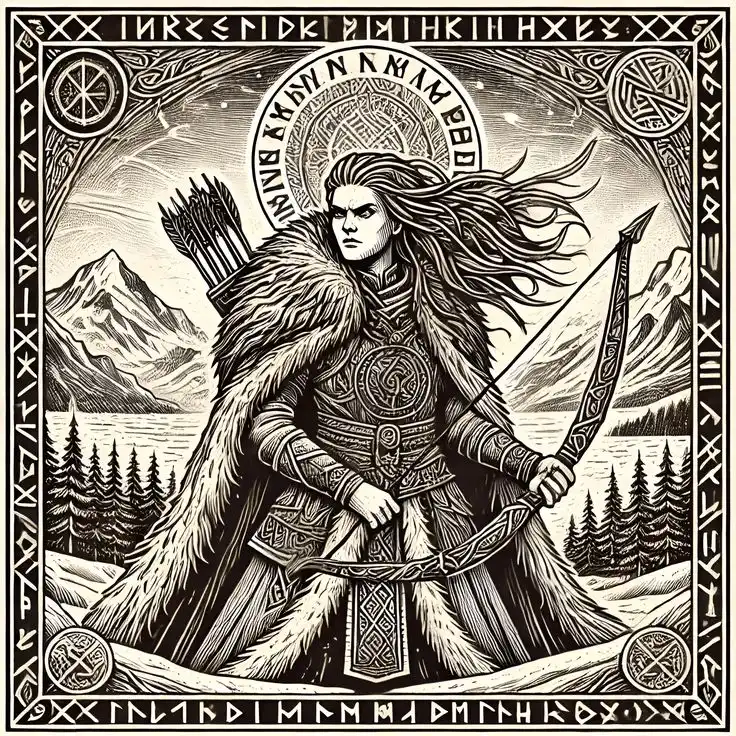
Source: Pinterest
Titles
Goddess of Winter
Snowshoe Goddess
Goddess of Mountains
Abilities
Skadi's exceptional abilities extend far beyond her mythological significance, encompassing a remarkable array of skills harmonizing with her domains. Her unparalleled expertise as a hunter is exemplified by her mastery of archery and tracking (“Skadi in Norse Mythology: Role & Family | Who Is Skadi?”), which underscores her unfailing connection to the primal forces of nature and her capacity to thrive within the untamed wilderness. Furthermore, her remarkable ability to navigate the treacherous expanses of mountains and snow-covered landscapes with almost supernatural ease is a testament to her status as a mountain goddess.
As a descendant of the Jotunn, Skadi possesses exceptional strength and endurance that transcends the limits of ordinary mortals (Hardy). These physical attributes augment her image as an independent and resilient figure capable of adapting to multifaceted challenges. Skadi's abilities embody her divine dominion over winter and the hunt and her intrinsic connection with the essence of the natural world, infusing her character with depth and power.
Characteristics
Skadi's regal and powerful presence serves as a testament to her deep connection with the rugged landscapes she governs. Depictions of Skadi often emphasize her awe-inspiring appearance, which acts as a visual echo of her profound affiliation with mountains and icy domains (Hardy). Her commanding stature and bearing draw a clear link between her physicality and the imposing grandeur of the mountains she dominates over, while her hair, often depicted akin to snow-capped peaks, serves as a visual metaphor, solidifying her association with wintry realms and icy landscapes that echo her mythic responsibilities.
Particular attention is paid to Skadi's piercing eyes that radiate with an unwavering determination, mirroring her unrelenting pursuit of justice and retribution (Hardy). This attribute reflects her indomitable spirit, echoed in the untamed demeanor she wears like a cloak of authority. In essence, Skadi's physical appearance bridges the gap between the divine and the terrestrial, conveying her majestic might while reflecting the fierce yet harmonious nature of the natural world she governs and personifies.

Source: The Musings Of An Obsessive Mind
Traits
Skadi's significance in Norse mythology transcends mere physical attributes, delving into the depths of her intricate personality. Her tale narrates a story of unwavering resolve, a testament to her courage and independent spirit (Hardy). Skadi's pivotal role in venturing into the realm of the Aesir gods to demand retribution for her father's demise underscores her firm commitment to justice (“Njord - New World Encyclopedia”). This audacious undertaking illuminates her determination and willingness to confront even the divine echelons.
Skadi embodies an unwavering strength and a nuanced vulnerability, adding a profound complexity to her character, rendering her more than just a symbol of power. She represents a harmonious blend of indomitable will and a receptive heart, a duality that paints her as a multifaceted figure within the Norse pantheon (“Skadi in Norse Mythology: Role & Family | Who Is Skadi?”). This intricate interplay of traits underscores her lasting appeal, inviting admiration and reverence from those who resonate with her narrative.
Symbols
Skadi's persona within Norse mythology is adorned with a rich tapestry of symbols, each representing distinct facets woven into her identity. The bow and arrow, quintessential instruments of the hunt, are an emblem of her unparalleled mastery in archery and tracking (“Skadi in Norse Mythology: Role & Family | Who Is Skadi?”), encapsulating her prowess and command over hunting. This skill bolsters her prominence, solidifying her position as a formidable force to be reckoned with.
The towering mountains and snow-blanketed landscapes are powerful symbols mirroring Skadi's dominion over unforgiving winter landscapes. These natural features aptly reflect the might and grandeur she embodies while highlighting the challenges she triumphs over. Furthermore, the wolf emerges as a poignant symbol aligned with Skadi's affinity for the wild and untamed. As seen in various cultures, the wolf is a creature that evokes notions of both ferocity and camaraderie, embodying Skadi's dual nature of strength and vulnerability (“Njord - New World Encyclopedia”). Together, these symbols weave a visual narrative that encapsulates her diverse roles as the goddess of winter, hunt, and wilderness, solidifying her place as a legendary figure in Norse mythology.
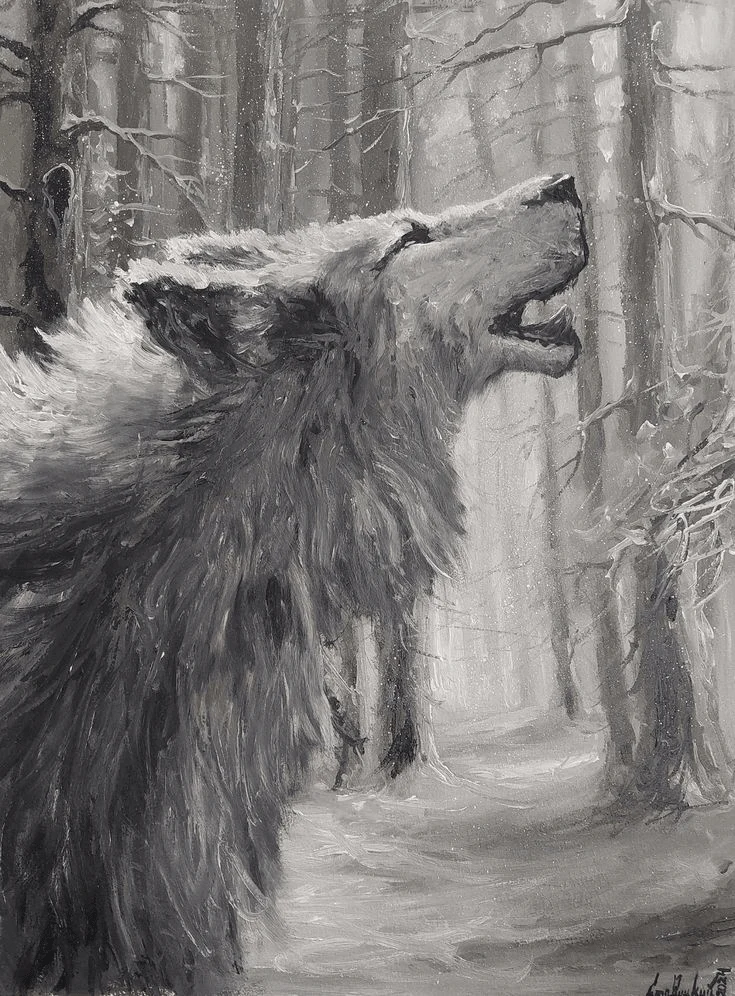
Source: Etsy
Festivals and Rituals
The veneration of Skadi is manifested through a tapestry of rituals and festivals that pay homage to her dual role as both the goddess of winter and the hunt. One of these significant occasions is the festival known as "Disting." This festival celebrated in the heart of late winter, is a vibrant celebration characterized by feasting and dedicated offerings (Hardy). The festival's timing is in harmony with Skadi's affiliation with the cold and formidable landscapes she reigns over (“Skadi in Norse Mythology: Role & Family | Who Is Skadi?”).
These rituals, intricately linked with Skadi's essence, are believed to encompass practices such as skiing and archery (“Skadi in Norse Mythology: Role & Family | Who Is Skadi?”). These activities, symbolic of her dominion, were likely performed by her devotees to invoke her blessings and favor. The art of skiing, intricately linked with her prowess in traversing treacherous snowy terrains, mirrored her resilience. Archery, a skill she epitomizes, cemented her reputation as a huntress par excellence.

Source: Pinterest
Legends associated with Skadi
The Norse mythology realm boasts many deities, each encapsulating the intricacies of both the human experience and the natural world. One such divine figure is Skadi, a goddess whose character is captivating and complex. She embodies the spirit of winter, hunting, and untamed landscapes, and her legends offer insight into the multifaceted dimensions of her personality, the influences of other cultures, and her enduring presence in the modern world.
Origin story
Skadi's origin story, a captivating narrative entwining tragedy, and determination, unfolds as a complex tapestry in Norse mythology. Her lineage is deeply enmeshed with the Jotnar, a race of giants intrinsic to Norse cosmology (Hardy). Notably, her father, Thjazi, stood as a giant renowned for his cunning and formidable prowess. Yet, his fate took a tragic turn, met at the hands of the Aesir gods for his audacious act of abducting Idun, the goddess of youth and vitality (“Njord - New World Encyclopedia”). This pivotal event catalyzed Skadi's journey, setting her on a path to reclaim justice for her father's demise. Her resolve to seek retribution epitomizes her unwavering spirit and resilience, establishing the foundation for the legends illuminating her extraordinary presence within the realms of gods and giants.
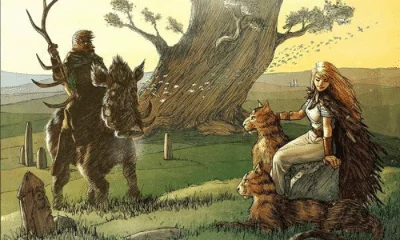
Source: Mythology Source
The Unlikely Union: Skadi's Quest for Justice and the Surprising Twist of Fate
Long ago, in the realms of the Aesir gods, a tragic event occurred that led to Skadi's quest for retribution. Her father's untimely demise at the hands of the gods compelled her to demand justice. Recognizing their fault, the gods sought to appease her by offering a unique proposition: the freedom to choose a husband from their midst. However, the twist was that Skadi had to base her choice solely on the feet of the potential suitors (Hardy). In a curious turn of events, Skadi chose Njord, mistaking his feet for those of the handsome god Baldr. Fueled by a mix of misunderstanding and fate, this decision led to an unexpected union between Skadi and Njord, encompassing contrasting domains.
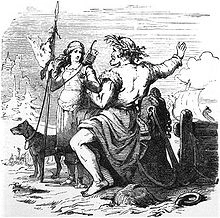
Source: Wikipedia
Unleashing the Power of Skadi: The Birth of the Northern Lights
Beyond her dominion over mountains and winter landscapes, Skadi was believed to have the ability to conjure powerful and awe-inspiring natural phenomena (“Njord - New World Encyclopedia”). Among these was the Northern Lights, a dazzling display of color and light that captivates observers today. Skadi's affinity for the harsh and unforgiving winter environments allowed her to harness the energy of the icy winds and snowstorms. In moments of contemplation and reverence, she would gaze toward the heavens, releasing her power and energy into the sky. This release of power and energy resulted in the birth of the Northern Lights, a cosmic spectacle that serves as a reminder of the intricate threads that bind Norse deities to the cosmos and the earthly realm alike.

Source: Bluethumb Online Art Gallery
Influences of other religions/cultures on Skadi
The intricate interplay of cultures and religions that have influenced Skadi's persona reveals a fascinating tapestry of ideas that have shaped her character. Notably, a connection between Skadi and the Vedic deity Ushas is significant as it highlights universal themes that transcend geographical and cultural boundaries. The parallel between Skadi and Ushas, the embodiment of dawn and the ethereal splendor of the natural world (“Njord - New World Encyclopedia”), showcases the interconnectedness of diverse belief systems. The juxtaposition of Norse and Vedic attributes encapsulates a shared reverence for the beauty of the natural world and its symbolism. This exchange of ideas across different mythological systems is intriguing and highlights the importance of exploring different cultures and religious traditions.
Modern appearances
Skadi's legacy transcends time, leaving an indelible mark on modern culture that echoes throughout various avenues. Her influence is most notably felt in winter sports and recreational pursuits, where her name is often used to adorn skiing competitions and events (Wikipedia Contributors). This fitting homage pays tribute to her mythic mastery while underscoring the symbolic link between her persona and the wintery domains she governs. Indeed, Skadi's dominion over snow-clad landscapes has been celebrated for centuries, and her enduring legacy is a testament to the power of myth and legend in shaping our cultural consciousness.
Final thoughts
The chronicles of Norse mythology boast a captivating figure in the form of Skadi, who embodies a striking duality of strength and vulnerability, winter's icy grip, and the mesmerizing charm of unspoiled landscapes. Her legends, which recount her tireless pursuit of justice and her enigmatic marital pursuits, evoke the ethereal beauty of the northern lights while illuminating the intricate layers of her character.
The contributions of other cultures and religions lend further nuance to Skadi's narrative, underscoring the universal relevance of her themes. As her story transcends time, Skadi's timeless presence in contemporary contexts underscores her ongoing significance. Her mythos serves as a testament to the profound depths and complexities that flourish within the human imagination, intertwined with the eternal allure of the divine. Across generations, Skadi continues to captivate and resonate, embodying the essence of mythological storytelling that transcends cultural boundaries and reminds us of the shared threads that unite humanity's collective imagination.
References
Hardy, James. “Skadi: The Norse Goddess of Skiing, Hunting, and Pranks | History Cooperative.” History Cooperative , 10 Mar. 2023, historycooperative.org/skadi/. Accessed 15 Aug. 2023.
“Njord - New World Encyclopedia.” Www.newworldencyclopedia.org, www.newworldencyclopedia.org/entry/Njord.
“Skadi in Norse Mythology: Role & Family | Who Is Skadi?” Study.com, 2023, study.com/academy/lesson/skadi-norse-mythology-role-family.html. Accessed 15 Aug. 2023.
Wikipedia Contributors. “Skaði.” Wikipedia, Wikimedia Foundation, 11 Feb. 2020, en.wikipedia.org/wiki/Ska%C3%B0i.
Hel: Queen of Helheim and Goddess of Death

Source: Pinterest
The goddess Hel, known for her enigmatic presence in the realm of the underworld, has long captured the imagination and interest of scholars and storytellers alike. Embodying the delicate balance between life and death, Hel has drawn the attention of generations and inspired contemplation and exploration into the realms of Norse belief and beyond. Hel's dualistic nature, reigning over the ethereal kingdom of Helheim while being deeply enmeshed in the perpetual cycle of existence, is a constant reminder of the intricate balance that shapes the universe. Both ancient and contemporary observers are drawn into her captivating narrative, woven with threads of life and death, inviting us to unravel the enigma that is Hel.
Overview of Hel
The realm of the dead in Norse Mythology was originally called Hel, but over time, it became associated with the goddess of death who ruled over Helheim - the land of the deceased. Hel, also known as Hela or Hella, played an essential role in Norse mythology as the supreme ruler of the underworld (“Hel (Mythological Being)”). According to historical accounts, she was born from the unconventional union of the mischievous trickster god Loki and the mysterious giantess Angrboda. Her authority over the afterlife is not limited to governance but also symbolizes the cyclical nature of life and death intrinsic to the Norse cosmology (“Hel - New World Encyclopedia”). Hel embodies this profound cosmic rhythm, closely intertwined with mortal existence and divine eternity. Additionally, her dual heritage mirrors the inherent dualities of her realm - a place of refuge and comfort for some souls, while for others, it is a realm of darkness and isolation (McCoy).

Source: Pinterest
Titles
Mistress of the Underworld
Queen of Helheim
The Keeper of the Dead
Abilities
The influence of Hel extends far beyond the dichotomy of life and death, firmly establishing her as a linchpin in the delicate balance of the cosmos (“Hel”). As an arbiter of fate, Hel holds the power to shape the destinies of mortals, an authority that resonates even beyond the veil of death itself (Kabir).
At the core of her abilities lies the pivotal task of determining the ultimate afterlife destinations for souls. This prerogative highlights her role as a mediator between the realms, orchestrating the intricate transition dance from the mortal to the ethereal (“Hel (Mythological Being)”). Furthermore, Hel's capabilities extend to the realm of healing. Her unique aptitude for restoration grants her the ability to resurrect those who have faced near-fatal injuries or illnesses, thus weaving threads of life into the tapestry of death (McCoy).
Hel's dominion over the deceased grants her sovereignty and dynamic control over spirits. This dominion endows her with the power to command and guide these spectral entities (Kabir).
Characteristics
The visual representation of Hel's existence is a remarkable embodiment of the complex dichotomy between life and death (“Hel (Mythological Being)”). Her form, as depicted throughout history, is sometimes a canvas richly painted with intricate detail, showing a body divided into two contrasting halves (Kabir). One side radiates an ethereal beauty akin to that of the gods, while the other is veiled in morbidity, mirroring the decay intrinsic to the afterlife (“Hel”). This visual duality encapsulates Hel's pivotal role as an intermediary, poised between the animate and the deceased. However, several art pieces exclusively showcase Hel's ethereal beauty, while others fully embrace her darker side. Nonetheless, both aspects of her persona are frequently portrayed in art.
As a reminder of her place within the intricate cosmic dance, Hel's appearance embodies her profound purpose and unique heritage as a guiding force amid the ever-shifting tides of existence. Her physical portrayal is not simply an artistic choice but a reflection of her role as a bridge between the realms of the living and the dead (McCoy), a reminder of the delicate balance between life and death that underpins the fabric of the universe.
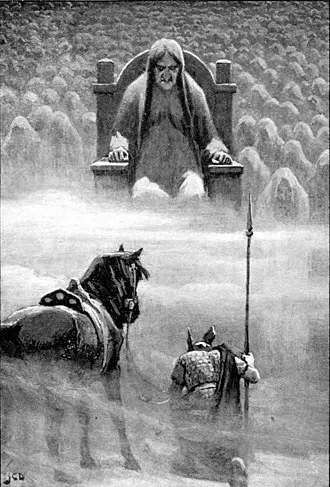
Source: Wikipedia
Traits
The association of Hel's realm with the departed may suggest a strict and unyielding demeanor. However, Hel's character is considerably multi-dimensional and exhibits a broad range of emotions and qualities that closely mirror the complex nature of her lineage. Beneath her enigmatic exterior lies a heart that resonates with compassion and morality (“Hel (Mythological Being)”). As the ruler of the realm of the deceased, her judgments bear significant consequences for the fates of departed souls (Kabir). Hel's innate empathy and understanding provide hope within her shadowy domain, reminding us that compassion and kindness can coexist alongside death (McCoy).
Symbols
The symbolism associated with Hel is deeply rooted in her integral role as a conduit between the realms, representing the transition from life to the afterlife. One of the most notable symbols linked to Hel's power is the "Helm of Awe," a complex emblem that exudes a sense of protection and strength (“Hel (Mythological Being)”). This icon is often associated with Hel's dominion over the afterlife, highlighting her role as a guardian of souls during their final journey (“Hel - New World Encyclopedia”). Similarly, the "Hringhorni," a ship that carries fallen warriors to the realm of the dead, is a potent symbol closely intertwined with Hel's mythology (McCoy). This vessel embodies her authority over fate, guiding departed souls through the sea of transition with a steady hand (“Hel”).
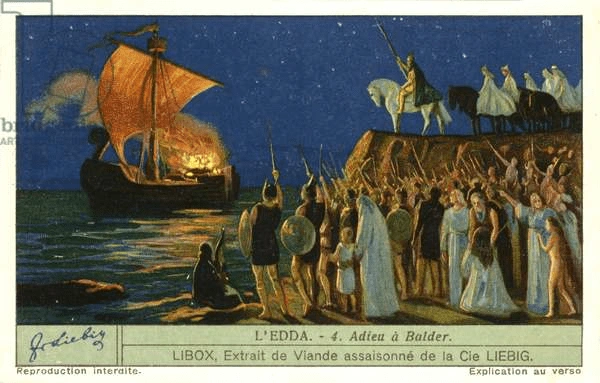
Source: Bridgeman Images
Festivals and Rituals
Hel's influence on Norse belief systems, particularly in ancestral veneration, is a topic of ongoing scholarly debate. Despite the lack of direct evidence of exclusive celebrations dedicated solely to Hel, her enduring presence as a mediator between the living and the deceased is reflected in broader observances such as the Dísablót (Kabir), a communal practice aimed at honoring ancestral spirits and feminine powers. During this ritual, offerings were presented to female entities, including the enigmatic Hel, praying for their favor and safeguarding (“Hel (Mythological Being)”). This homage highlights the intertwined destinies of the living and the deceased within Norse belief systems, underscoring Hel's integral role in the intricate dance of life and death (McCoy).
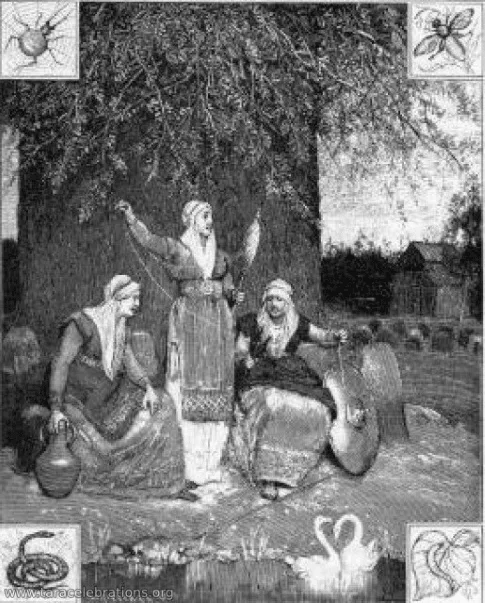
Source: Tara Celebrations
Legends associated with Hel
Amid the intricate weave of Norse mythology, the goddess Hel emerges as an enigmatic and influential figure. Delving into the legends surrounding her, we unearth her origin story and diverse narratives, unveiling facets of her captivating persona. These tales offer glimpses into the complexity that defines Hel, embodying both mystery and might within the rich tapestry of Norse lore.
Origin story
Following the Prose Edda by Snorri Sturluson, a notable source of Norse mythology, the origin of Hel can be traced back to the atypical union between Loki, the renowned trickster god, and Angrboda, a giantess with close associations to chaos and the untamed forces of nature (“Hel (Mythological Being)”).
The involvement of Loki in Hel's conception adds a layer of intrigue to her lineage. Loki, known for his shape-shifting abilities and propensity for stirring up trouble, defies the norms of the divine pantheon through his relationship with Angrboda. This union reflects both Loki's inclination towards chaos and the crossing of boundaries between gods and giants, as well as between divine and primal forces. Angrboda, whose name translates to "She Who Brings Grief," is intertwined with the untamed aspects of nature. The association with chaos and wilderness emphasizes Hell's lineage's unconventional and boundary-breaking nature. The offspring of this union embodies a unique blend of divine and chaotic traits, symbolizing a bridge between worlds and an embodiment of the dualistic nature intrinsic to Norse mythology (Kabir).
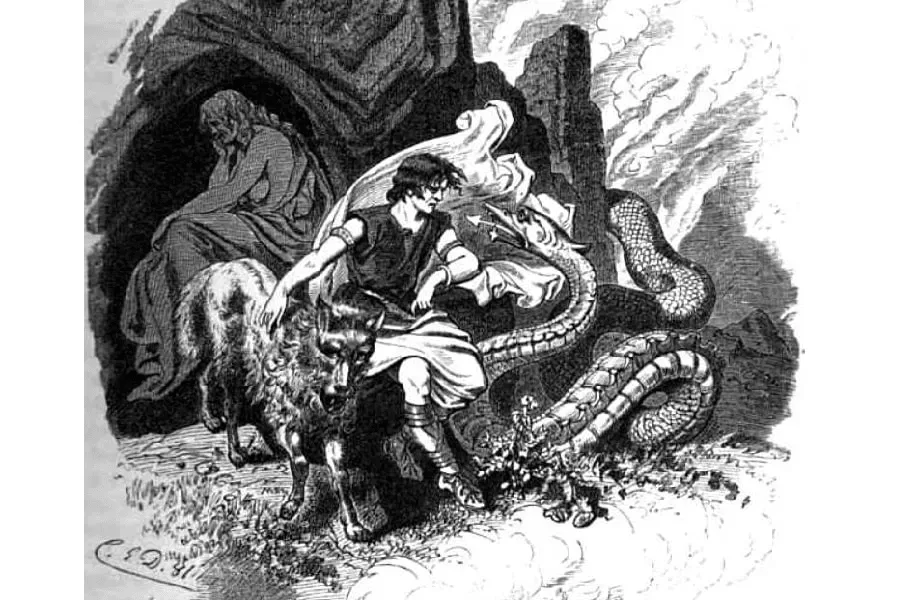
Source: History Cooperative
The End and the Beginning: Hel's Role in the Aftermath of Ragnarok
A great event known as Ragnarok marked the end of the world and the beginning of a new life cycle. This apocalyptic event brought about the total destruction of the cosmos, leaving only ashes and rubble in its wake. However, amidst the chaos and devastation, a figure emerged as a beacon of hope and renewal: Hel, the ruler of the realm of Helheim. As the final resting place for those who had passed away due to old age or illness, Helheim played a crucial role in the aftermath of Ragnarok. As its ruler, Hel was responsible for ensuring that the souls who did not meet their fate in battle found their rightful place in the afterlife (“Hel - New World Encyclopedia”). Her unwavering commitment to this task spoke to the enduring influence of her character on Norse belief systems.
Hel remained a central figure in this new life cycle as the world began to regenerate. Her role as a harbinger of cosmic change and renewal underscored the interconnectedness of all things, symbolizing the cyclical nature of existence. Hel's significance as a guardian of souls and participant in the cosmic upheaval of Ragnarok was undeniable, as she embodied the bridge between life and death (“Hel (Mythological Being)”).
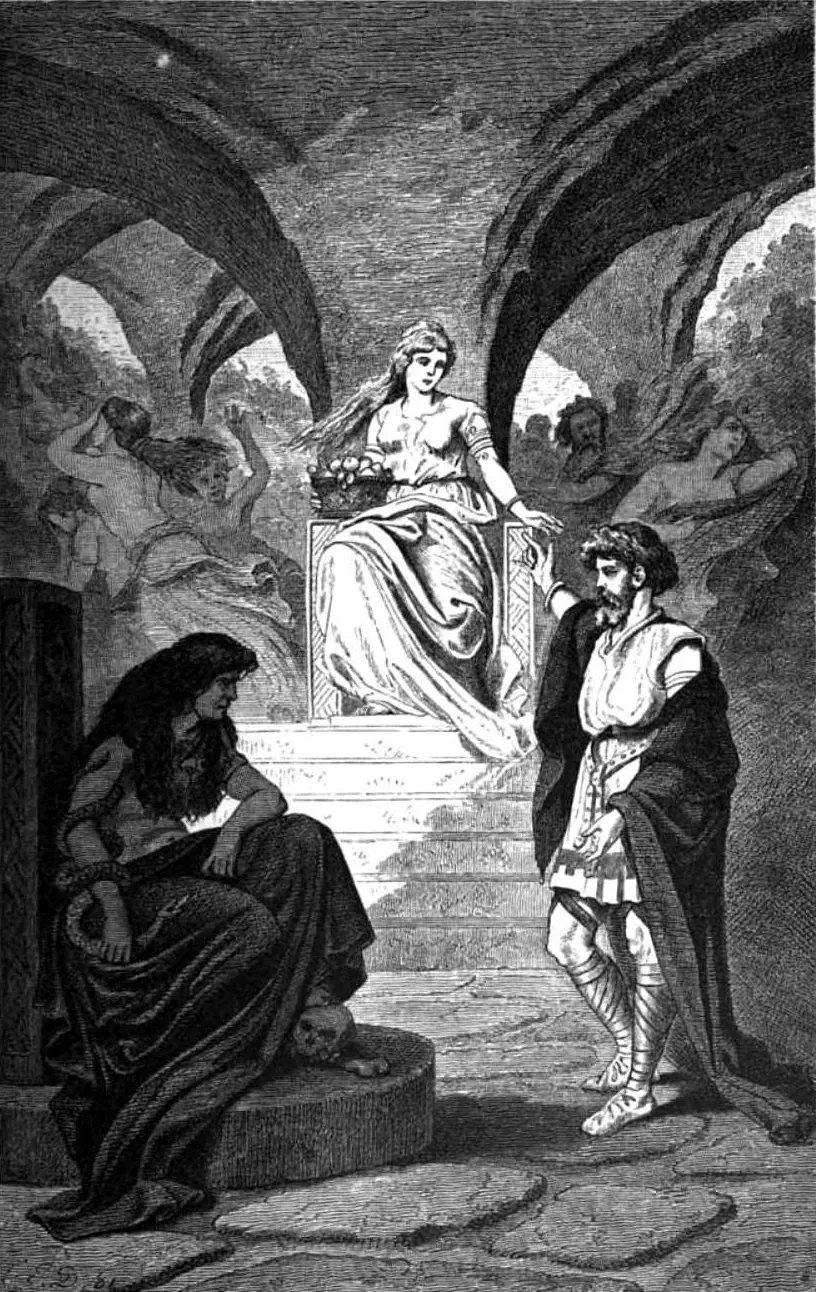
Source: Norse Mythology for Smart People
Legend 2
In the annals of Norse mythology, few tales are more heart-wrenching than the saga of Baldr and his accidental demise at the hands of his own brother, Hodr. This tragic event set in motion a chain of events that thrust Hel, goddess of the underworld, into the forefront of the cosmic order (“Hel”). Baldr, known for his invulnerability, was granted this gift by a mother's oath not to harm him. However, his vulnerability remained concealed from the gods, and Loki, the cunning trickster god, exploited this loophole, tricking Baldr's blind brother into firing a mistletoe dart that pierced his heart, causing his death. The death of this radiant god plunged the cosmos into mourning, underscoring the profound impact of his demise.
Following Baldr's untimely death, the gods sought to retrieve him from the realm of the dead, Helheim, ruled by the goddess Hel. This realm was a place of rest for those who did not die in battle, offering a peaceful afterlife. The gods sent emissaries, including Baldr's mother, the goddess Frigg, and Hermóðr, to negotiate with Hel for Baldr's return. Hel, embodying her role as the ruler of the afterlife, presented the gods with a condition: if all things wept for Baldr, he would be released from her realm. This condition underscored Hel's power and connection to the cyclical nature of life and death. While most beings wept for Baldr, Loki, in yet another act of deceit, disguised himself as a jötunn woman named Thökk and refused to shed tears, thus preventing Baldr's return. Baldr's death and sojourn to Helheim revealed Hel's position as a mediator between realms. Her realm became a place of solace and reprieve, even for revered gods like Baldr (“Hel - New World Encyclopedia”).
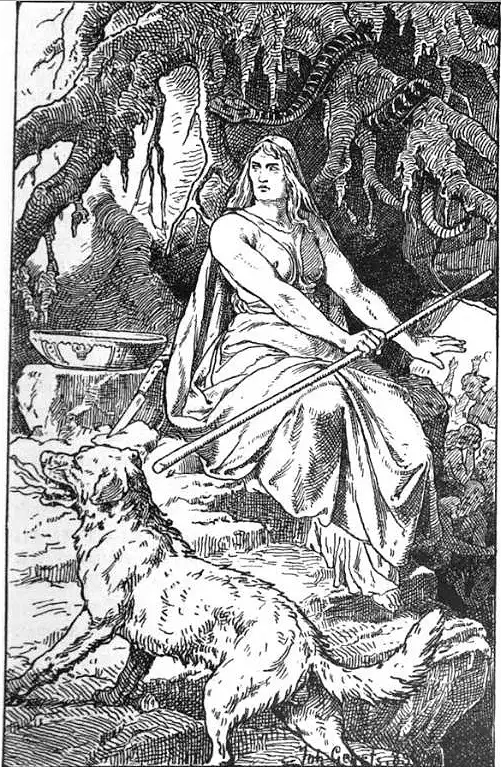
Source: Wikipedia
Influences of other religions/cultures on Hel
The enigmatic presence of Hel within Norse mythology extends beyond the confines of its cosmology, as her character bears subtle influences from diverse cultures and belief systems. Although firmly rooted in the Norse pantheon, Hel's role as a deity overseeing the realm of the dead resonates with echoes from other mythologies. The motif of a divine ruler presiding over the afterlife is a universal theme that transcends cultural boundaries. Hel's dominion over the deceased shares intriguing parallels with various underworld figures from different mythologies, such as Hades, the Greek god who holds authority over the realm of the dead in Greek mythology (Kabir). The resemblance in their roles underscores the timeless human fascination with the realm beyond mortal existence, illustrating the universality of themes surrounding death, rebirth, and the afterlife.
As the lines blur between cultural narratives, Hel's character emerges as a testament to the interconnectedness of human mythmaking. The similarities between her and other underworld figures reflect the innate human yearning to comprehend the mysteries that lie beyond life's horizon, a yearning that transcends geographical and cultural boundaries. Thus, Hel's multifaceted character is a poignant reminder of the enduring curiosity and wonder that permeates human mythology.
Modern appearances
The legacy of Hel, a prominent figure in ancient Norse mythology, has transcended time and continues to resonate with modern sensibilities. Her enigmatic persona has seamlessly transitioned into various modern media outlets, leaving an indelible mark on literature, movies, and video games. Notably, Hel or Hela appears in the Marvel Cinematic Universe (MCU) films, particularly in the movie "Thor: Ragnarok." In the MCU, Hela is portrayed as Thor's older sister based on the Norse mythology figure Hel. Depicted as a powerful and formidable villain, Hela can control death and rule over the realm of the dead. The adaptation of her character in "Thor: Ragnarok" highlights her connection to the apocalyptic event of Ragnarok, a role that mirrors her significance in Norse mythology
Final thoughts
Hel, in all her complexity, varied legends, and cultural influences, serves as a testament to mythology's intricate and interconnected nature. Her role as a bridge between life and death, her embodiment of duality, and her enduring impact on popular culture highlights her significance within the pantheon of Norse deities. As we navigate the rich tapestry of Norse mythology, the character of Hel serves as a reminder of humanity's timeless fascination with the mysteries that exist beyond the mortal realm.
References
“Hel.” World History Encyclopedia, www.worldhistory.org/Hel/.
“Hel (Mythological Being).” Wikipedia, 21 Nov. 2022, en.wikipedia.org/wiki/Hel_(mythological_being).
“Hel - New World Encyclopedia.” Www.newworldencyclopedia.org, www.newworldencyclopedia.org/entry/Hel.
Kabir, Syed Rafid. “Hel: Norse Goddess of Death and the Underworld | History Cooperative.” History Cooperative, 12 Jan. 2023, historycooperative.org/hel-norse-goddess-of-death/.
McCoy, Daniel. “Hel (Goddess) - Norse Mythology for Smart People.” Norse Mythology for Smart People, 2012, norse-mythology.org/gods-and-creatures/giants/hel/.
Idun: Goddess of Youth and Rejuvenation
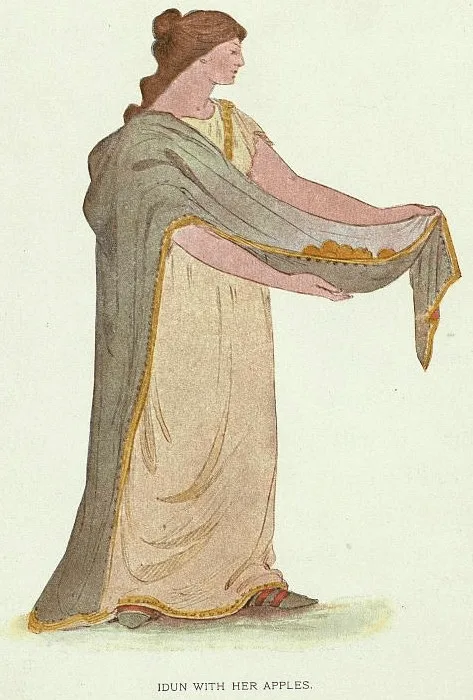
Source: Reusable Art
In the realm of Norse mythology, a revered deity's paramount duty lies in safeguarding the elixir of youth and vitality, thereby ensuring the perpetual spring of life for the gods. This deity is Idun, a goddess whose significance transcends far beyond her role as a guardian of apples. With a deep dive into the vast expanse of Norse mythology, Idun's intricate nature is revealed by examining her multifaceted titles, abilities, characteristics, traits, and symbols, as well as the festivals and rituals dedicated to her divine presence.
Overview of Idun
Derived from the Old Norse language, the name "Idun" bears a rich meaning, signifying "the young one" or "the rejuvenator'' ("Idun"). In Norse mythology, Idun, also known as Iðunn or Iduna, is the protector of the sacred apples of youth (Mark). These apples embody both a physical fruit and the cyclical nature of life, representing the invigorating forces at existence's core. However, Idun's significance transcends her immediate function, given that her presence contributes directly to the gods' enduring strength and vitality ("Idun"). As a nurturing and compassionate figure, Idun occupies a unique and revered place in the pantheon, encapsulating the essence of rejuvenation, a critical aspect of Norse cosmology.

Source: Myths and Folklore Wiki
Titles
Guardian of the Golden Apples
Bearer of Eternal Youth
Custodian of Life’s Nectar
Abilities
Idun's mastery over the mythical apples of youth is a fundamental and indispensable aspect of her dominion and an integral component of Norse mythology ("Idun"). These vitality apples are the gods' source of strength and longevity, and their well-being is intrinsically linked to the fruit's existence (Mark). However, Idun's role extends far beyond mere fruit-bearing, as she also serves as the appointed guardian of the apples, shielding the gods from the effects of aging and the relentless march of time. Her unparalleled ability to nurture and safeguard these apples reflects her divine connection to the timeless cycle of existence, underscoring her central role in maintaining the ageless vitality of the gods. Ultimately, the consumption of the apples by the gods serves as a pact with the eternal, an arrangement that Idun ensures is upheld with great care and meticulous attention to detail.
Characteristics
The physical portrayal of Idun is inherently aligned with her pivotal role as a harbinger of eternal youth ("Idun in Norse Mythology | Origin, Role & Symbol"). This characteristic is often attributed to her appearance in Norse mythology, where she is revered as a goddess of great vitality, resonating with the perpetual spring of life she embodies. Her radiant visage, exuding a sense of vibrancy, is further enhanced by her lustrous hair, described as a cascade that shimmers akin to sunlight. Her eyes, exuding a pearl of wisdom that transcends ages, merge seamlessly to encapsulate the essence of beauty and sagacity (Mark), complementing her embodiment of the grace inherent in nature.
Moreover, her aura of tranquility envelops those around her, instilling a sense of security and solace. This gentle yet resolute demeanor is the hallmark of her guardianship, reflecting her solemn duty as the protector of life's most treasured essence - the timeless vitality encapsulated within the apples she holds in her care ("Idun"). Thus, Idun's depiction is a testament to the enduring power of nature and the importance of preserving its sanctity.
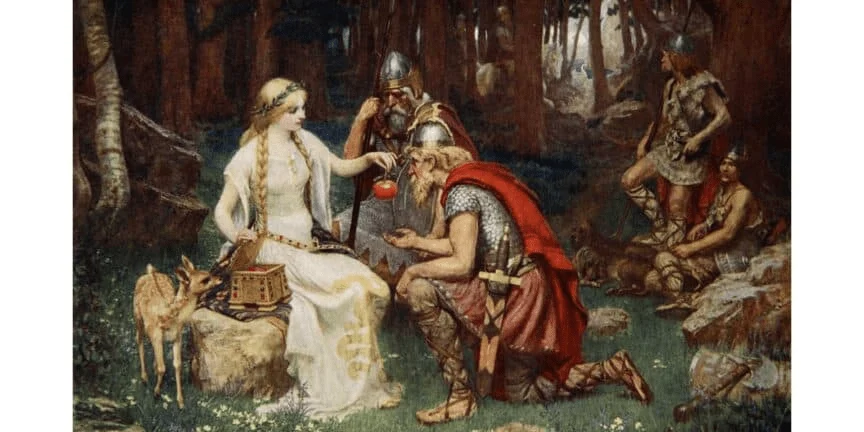
Source: Nordic Culture
Traits
Idun stands out not just for her physicality but for the virtues that define her role as a guardian and nurturer (Wikipedia Contributors). Her compassion, patience, and unwavering commitment are the foundation of her personality, reflecting the harmony of her sacred duty. As a custodian of the gods' well-being, she exudes a nurturing love that cultivates a thriving environment and fosters unity (“Idun”). Her dedication is not limited by time, as her steadfastness in safeguarding the apples symbolizes a loyalty that transcends the ages (“Idun - New World Encyclopedia”). These qualities make her a deity deserving of reverence and admiration. Beyond being an apple-bearer, Idun is a beacon of virtues that sustain the gods and echo throughout the cosmos, promoting unity, strength, and eternal renewal. Her character shines bright, and her role as a guardian inspires and uplifts those around her.
Symbols
The symbolism surrounding Idun carries deep resonance, encapsulating her essence as a life-giver and nurturer. Her most prominent symbol, the golden apple, represents much more than its tangible form. It embodies the core of her role - the preservation of youth and immortality, a beacon of unwavering vitality (“Idun”). In addition, Idun's association with blossoming flowers and lush orchards deepens her symbolic resonance, reflecting the cycles of renewal and growth that echo the perpetual rhythms of nature (“Idun in Norse Mythology | Origin, Role & Symbol”). The unfurling petals and fruit-bearing branches align with her guardianship, reinforcing the concept of eternal rejuvenation. The symbolism encompassing Idun forms a mosaic that mirrors her divine role, woven with the threads of youth, vitality, and the ceaseless cadence of life's renewal.
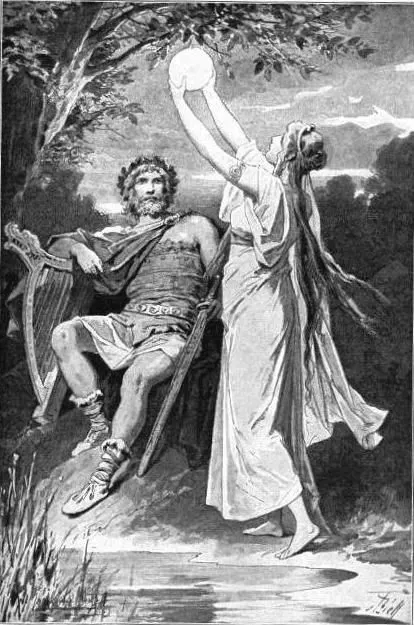
Source: Bridgeman Images
Festivals and Rituals
The "Festival of Apples," an event strategically aligned with the spring equinox. This occasion, marked by offerings of fruits and flowers, emerges as a tangible expression of gratitude for Idun's unwavering guardianship (“Idun - New World Encyclopedia”). These offerings, as a form of reverence, symbolize the acknowledgment of her role in safeguarding the gods' eternal strength. The rituals undertaken during this festival are multifaceted, including earnest prayers for perpetuating power and youth (“Idun in Norse Mythology | Origin, Role & Symbol”). These rituals reinforce a profound connection between the gods and their beloved protectors, underscoring the symbiotic relationship between divinity and vitality. Through these time-honored observances, Idun's presence continues to resonate, fostering a sense of unity and renewal within the pantheon.
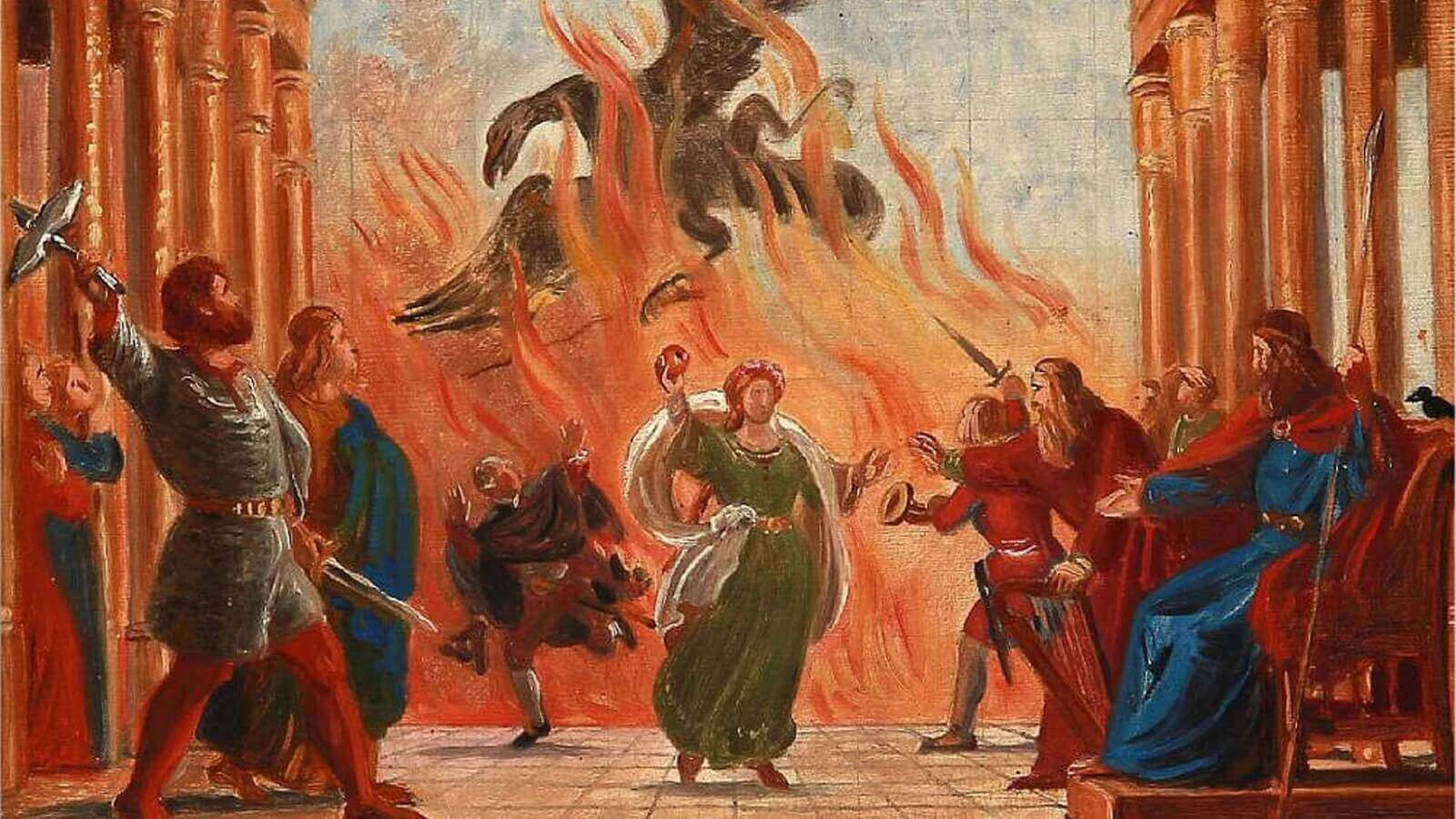
Source: Odin's Treasures
Legends associated with Idum
As a revered goddess responsible for guarding perpetual youth and vitality, Idun's legends are steeped in intricate details and fascinating complexities. Through a closer examination of the various myths surrounding her existence, we can better understand her multifaceted nature and the profound impact she had on the Norse pantheon of deities. With her ability to sustain the vigor and vitality of the gods, Idun holds a significant place in this ancient and fascinating belief system.
Origin story
The enigmatic origins of Idun, the mythical deity, have been the subject of much scholarly discussion and debate. While some accounts place her as a crucial member of the Aesir pantheon (Mark), others attribute her ancestry to Ivaldi and Gróa, adding a complex and intricate layer to her character (Wikipedia Contributors). Regardless of the lack of a definitive consensus on her beginnings, one thing remains abundantly clear: Idun bears the crucial responsibility of safeguarding the essence of life, which is interwoven into the very fabric of existence. Though her role as the guardian of life's essence is not frequently mentioned, it underscores her immense significance within the celestial hierarchy.

Source: Wikipedia
The Abduction of Idun's Apples
The saga of Idun's apples is a captivating and timeless tale that not only entertains but also sheds light on the intrinsic relationship between Idun's custodial responsibilities and the gods' timeless potency. This legendary story recounts the cunning trickster deity Loki's nefarious scheme to abduct Idun and the prized apples she guards from the sacred confines of Asgard. As the guardian of the sacred apples of youth, Idun's role becomes paramount, as her apples are the source of the gods' agelessness. By severing the lifeline that sustains the gods' vitality, Loki effectively causes their once-mighty strength to wane, and their eternal youth begins to slip away. This decline highlights the fundamental connection between Idun's apples and the gods' everlasting vigor.
The gods, realizing the source of their woes, unite to apprehend Loki and undo his evil deed. The resolution of this tale culminates in Loki's eventual compliance, as he is compelled to restore Idun to her rightful place among the gods. The restitution of the apples heralds a renewal of the gods' strength and reaffirms the apples' status as a symbol of eternal rejuvenation (Mark).
Beyond its narrative charm, this legend symbolizes the profound bond between Idun's apples and the foundation of the gods' timeless potency. It underscores Idun's critical role in maintaining the balance of the gods' power and vitality. Moreover, it highlights the importance of vigilance and stewardship in safeguarding the sacred artifacts that sustain the gods' immortality. The saga of Idun's apples serves as a timeless reminder of the delicate balance between the forces of good and evil and the role that guardians like Idun play in preserving the sanctity of the divine realm.

Source: Apples & People
The Treachery of Thjazi
The mythological tale of the "Treachery of Thjazi" is a compelling narrative that explores the unyielding pursuit of power and the lengths one may go to acquire it. Thjazi, a formidable eagle giant, harbors a covetous desire for the transformative potency encapsulated within the mythical apples of Idun, driven by an insatiable yearning for their remarkable properties. His unrelenting pursuit culminates in the abduction of Idun, plunging the realm of the gods into a profound crisis that reverberates with the echoes of diminished vitality and existential vulnerability.
Only through the intervention of the cunning and resourceful Loki is Idun liberated from Thjazi's clutches, embodying the virtues of bravery and strategic wit in the face of overwhelming adversity. The legend concludes with retribution befall Thjazi due to his treacherous ambitions ("Idun"), underscoring the intricate interplay between power, vulnerability, and the unwavering commitment of deities like Idun to safeguarding the sacred threads of existence.
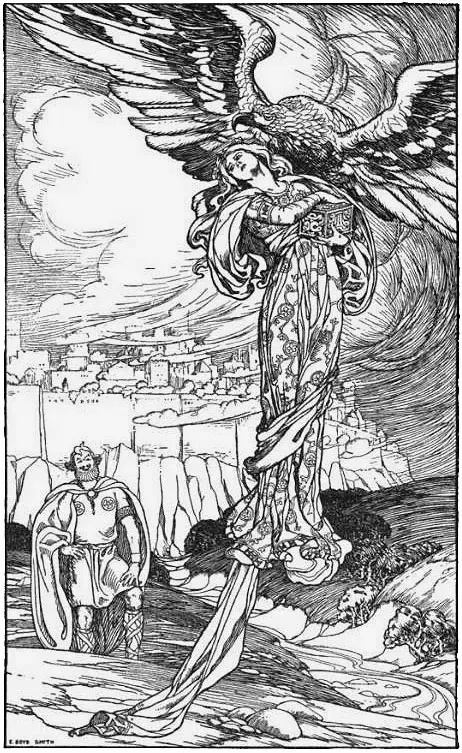
Source: Britannica
Influences of other religions/cultures on Idun
The goddess, Idun's significance within Norse mythology is subtly shaped by neighboring belief systems, emphasizing the universal theme of eternal youth and vitality. While direct cross-cultural influences are not extensively documented (Mark), the agelessness and perpetual renewal symbolized by her apples become a universal motif, bridging diverse cultures and reflecting the shared human desire to transcend the limits of mortality. As the guardian of vital essence, Idun's role and her apples as symbols of everlasting rejuvenation become points of convergence across religions. The archetype of perpetual renewal embedded in Idun's spirit reflects the fundamental human need to seek transcendence and continuity amidst the ephemeral nature of existence, emphasizing the universal quest for timeless vitality.
Modern appearances
The significance of Idun, the Norse deity associated with eternal youth and vitality, has extended beyond the boundaries of mythology, permeating various aspects of popular culture. Notably, the Idunn Mons, a volcano located on Venus, was named in honor of the goddess. The iconic Swedish magazine Idun circulated from 1887 to 1963 prominently featured the goddess and her apples on its logo. Additionally, in the video game God of War (2018), players can collect items known as “Apples of Idun,” which provide a permanent health boost (“Idun”).
Final thoughts
Idun's position in Norse mythology is not limited to a mere deity but extends to a guardian of an eternal wellspring. The tales surrounding her character add depth and complexity to her divine essence, highlighting her critical custodial role. From stories of abductions to agreements with the gods, Idun's legends underscore the importance of her role in Norse mythology. Moreover, Idun's aspiration for eternal youth continues to resonate within the human spirit. Ultimately, Idun's impact on Norse mythology and her universal symbolism of everlasting vitality remain deeply ingrained in the intricate fabric of human narratives.
References
“Idun.” Mythopedia, mythopedia.com/topics/idun.
“Idun - New World Encyclopedia.” Www.newworldencyclopedia.org, www.newworldencyclopedia.org/entry/Idun. Accessed 20 Aug. 2023.
“Idun in Norse Mythology | Origin, Role & Symbol.” Study.com, 2023, study.com/academy/lesson/idun-norse-mythology-origin-role-symbol.html. Accessed 20 Aug. 2023.
Mark, Joshua J. “Idunn.” World History Encyclopedia, www.worldhistory.org/Idunn/.
Wikipedia Contributors. “Iðunn.” Wikipedia, Wikimedia Foundation, 14 Aug. 2019, en.wikipedia.org/wiki/I%C3%B0unn.
Like this project
Posted Sep 27, 2023
A client hired me to write a collection of pieces centered around the Norse Goddesses Frigg, Freya, Skadi, Hel, and Idun.
Likes
0
Views
1.6K
Timeline
Aug 3, 2023 - Sep 27, 2023
Clients

Grounded Insights




